Energy return in running shoes explained
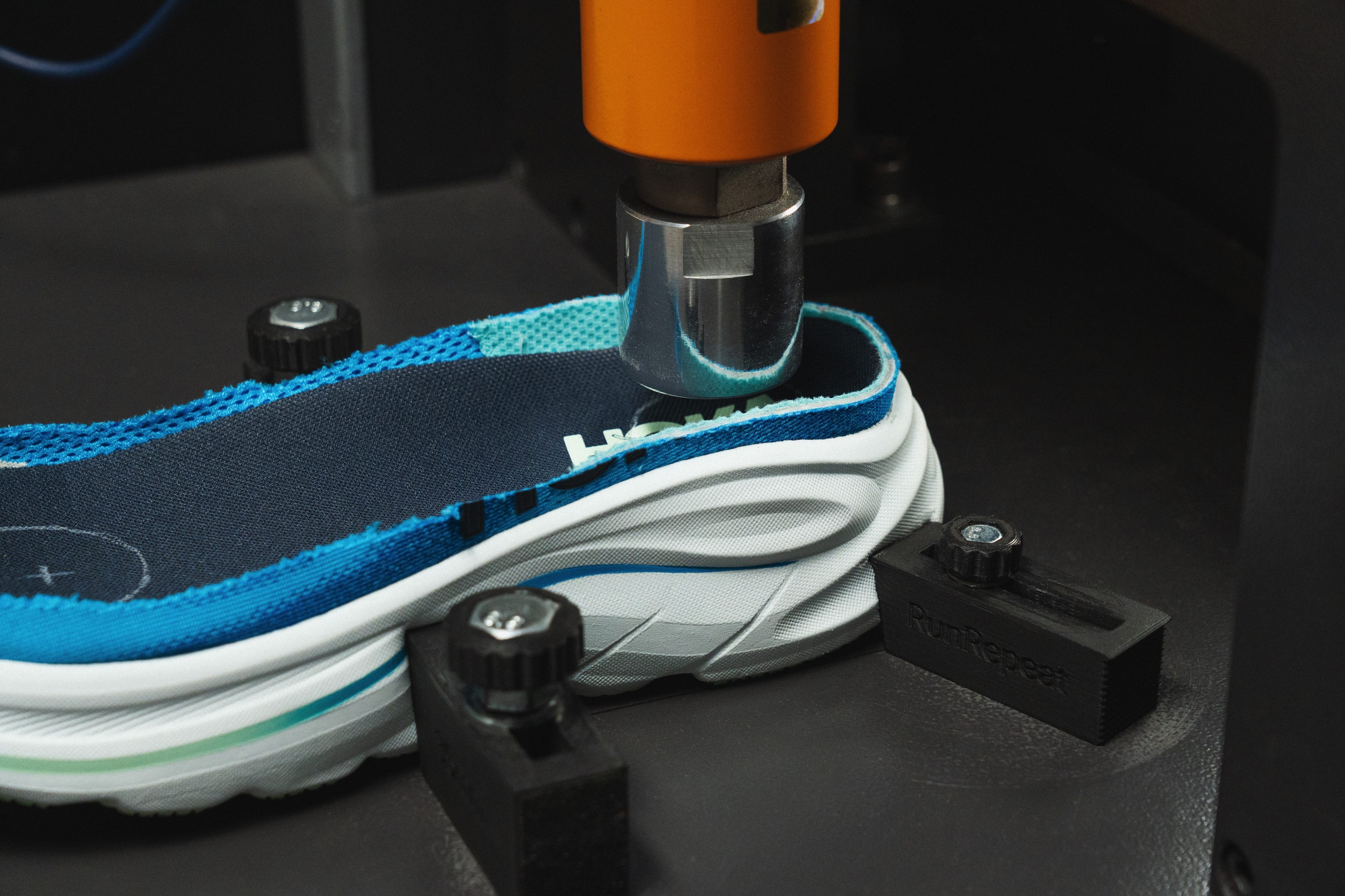
The phrase “energy return” has only gained attention in the last decade as advanced materials like TPU, TPEE, PEBA, and A-TPU entered the scene. This guide covers every nuance about energy return based on our lab data (500+ shoes tested for energy return) and consultations with lots of experts on the topic.
What is energy return and why it’s important in running shoes
Energy return in running shoes refers to how efficiently the midsole foam rebounds after being compressed during a step. Instead of absorbing all impact as heat, a running shoe stores some energy and releases it as the foot lifts off.
This rebound helps reduce wasted effort and can improve running economy, though only if the shoe’s design, timing, and stiffness align well with the runner’s biomechanics and stride.
Common misconceptions about energy return
In this section, we’ll break down some of the most frequent misunderstandings surrounding energy return and how it’s often confused with other shoe characteristics.
Energy return and running economy
Better energy return from a shoe can improve your running economy—but not always. For example, a heavier shoe with amazing energy return might still require more effort than a lighter shoe with slightly less energy return. Weight, stiffness, and geometry all influence the result.
Running economy is how efficiently your body uses energy while running at a steady pace. The better your running economy, the less oxygen or effort you need to maintain a given speed. It’s like a car when it uses less fuel to cover the same distance at the same speed. That saved energy can help you go farther, feel fresher, or run slightly faster.
To measure running economy accurately, we need to use lab tests. The runner wears a mask connected to a machine that tracks oxygen use while running in different shoes at the same speed. This is how Nike proved that the Vaporfly 4% reduced energy use by about 4%.
By the way, a 4% gain in running economy means your body uses 4% less energy to run at the same pace. However, only part of that saved energy becomes speed. Some of it helps reduce fatigue or smooth your stride. That’s why the real-world time gains are usually closer to 2 or 3%, as demonstrated by this study. This gap exists because the relationship between energy use and speed isn’t perfectly linear.
Energy return and shock absorption
The rise of energy return in modern foams has led some runners to confuse bounce with shock absorption. But these are two very different things.
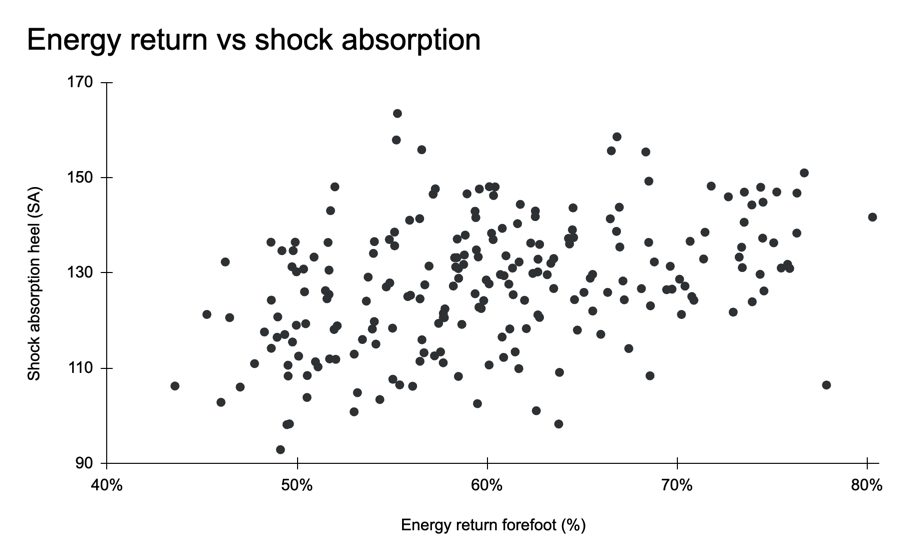
As you can see in the chart, there’s no strong correlation between energy return and shock absorption. Some shoes with high energy return also offer high shock absorption, but others don’t. That's a clear indicator that the two qualities don’t go hand in hand.
We also see plenty of overlap around the 60–65% energy return range, with shock absorption values ranging from about 100 to over 160 SA. This confirms that shock absorption depends on more than just the foam’s bounce, as other design elements like geometry, stack height, and midsole width play a big role.
Picking four random shoes is another simple way to show that there’s no direct correlation between the two.
| Shoe | Energy Return (Heel - %) | Shock Absorption (Heel - SA) |
| Hoka Bondi 9 | 60.2 | 146 |
| ASICS Gel Nimbus 27 | 47.7 | 136 |
| Nike Streakfly 2 | 76.3 | 106 |
| Adidas Pureboost 23 | 69.5 | 108 |
It's also quite interesting to see that energy return and shock absorption change a lot between running shoe categories.
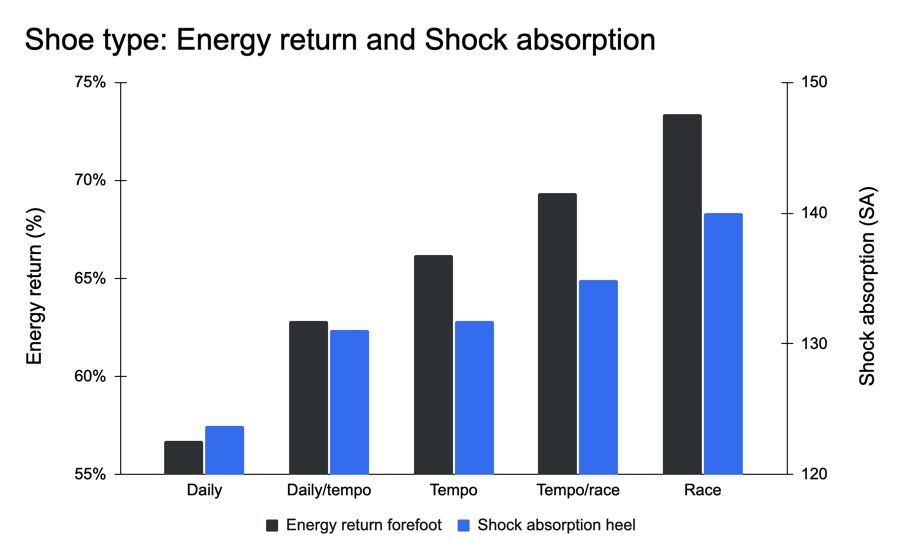
This chart reveals a nuanced relationship between energy return and shock absorption across different shoe types. As shoes shift from daily trainers to supershoes, energy return increases steadily, from around 56% in daily trainers to over 70% in racing shoes. This reflects the progressive use of more bouncy foams like PEBA or A-TPU. Shock absorption also improves, but the trend is less steep and more irregular.
In mid-tier shoes like those in the tempo category, shock absorption lags behind energy return slightly, hinting at a possible tradeoff when brands aim to balance weight, cost, and performance. Therefore, while energy return and shock absorption can rise together, their relationship is not strictly linear and depends heavily on foam quality.
Energy return and stack height

This scatter plot clearly shows that stack height and energy return aren’t strongly linked. In fact, some shoes with towering 40 mm midsoles deliver under 55% energy return, while others with more moderate stacks come close to 80%.
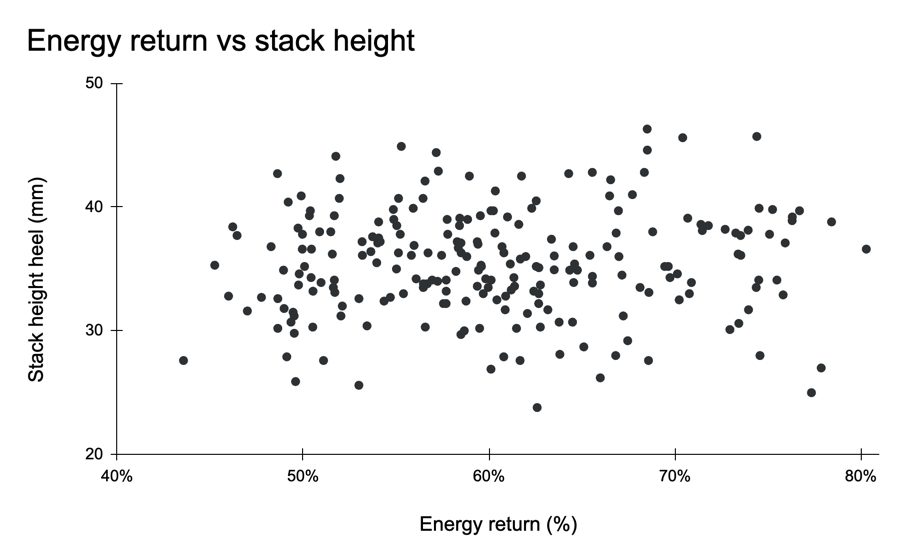
So it's very clear that thickness alone isn’t the key, and what really matters is the foam itself. The material, its formulation, and how it's engineered make the biggest difference in bounce and responsiveness. That’s why a 28 mm shoe with a PEBA midsole can easily outperform a 45-mm model packed with standard EVA in terms of energy return.
The key role of energy return in modern supershoes

Chances are that if you ran a race in 2017, most shoes around you were red, as almost every serious runner was wearing the Nike Vaporfly 4% Flyknit. Fast forward to 2019, and the scene turned green and pink with the Nike Vaporfly Next%. But now, almost every brand offers a supershoe with comparable (or even better) performance.
If you have a good memory and consider yourself a running shoe geek like us, you might remember how some brands rushed to counter Nike with lightweight models featuring carbon plates—like the Adidas Adizero Pro (not to be confused with the Adizero Adios Pro) or the Hoka Carbon X 3. But those early attempts didn’t work at all, the legs still felt trashed during and after marathons and times weren’t dropping at all.

This shows that modern superfoams with high energy return are essential in today’s supershoes. When Adidas launched Lightstrike Pro or ASICS developed FF Turbo, suddenly you looked around during races and saw more options than just Nike. And elite marathoners started to post Vaporfly-like times.
But even in 2025, we still don’t fully understand why supershoes are so effective. However, what studies have shown is that a true supershoe combines three elements: a foam with high energy return, a stiffening agent (usually a carbon plate), and lightweight construction. In other words—energy return alone won’t make you faster.
Lighter running shoes usually have more energy return. But, why?
One of the best parts of testing hundreds of shoes at RunRepeat is uncovering trends from real data—and one of the clearest is that lighter shoes often deliver higher energy return.
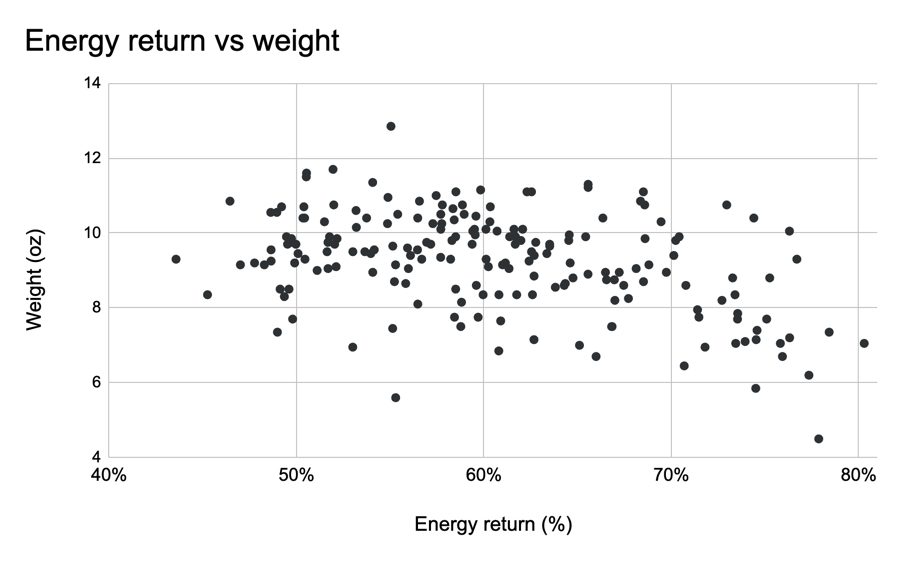
But that doesn’t mean simply reducing weight will make a shoe bouncier. What really happens is that supershoes usually feature advanced foams like PEBA or A-TPU, which are both lighter and more responsive than EVA.
At the same time, it’s important to remember that lower weight alone still brings benefits. It won’t boost energy return, but it can improve running economy—shaving 100g from a shoe is widely linked to a ~1% gain.
Does your strike pattern matter for energy return?
Yes, it does. Aside from Altra and a few niche brands, nearly every running shoe on the market is built with a higher heel than forefoot. That might make you assume there’s more foam in the heel. Well, it depends.
Take the Adidas Prime X 2 Strung as an example. We found in the lab that it stacks up with 45.7 mm in the heel and 36.9 mm in the forefoot, creating an 8.8 mm drop. However, its platform tells a different story: the forefoot is 115.2 mm wide, while the heel is just 81.6 mm. So the forefoot may be shorter in height, but its width gives it more foam to store and release energy.
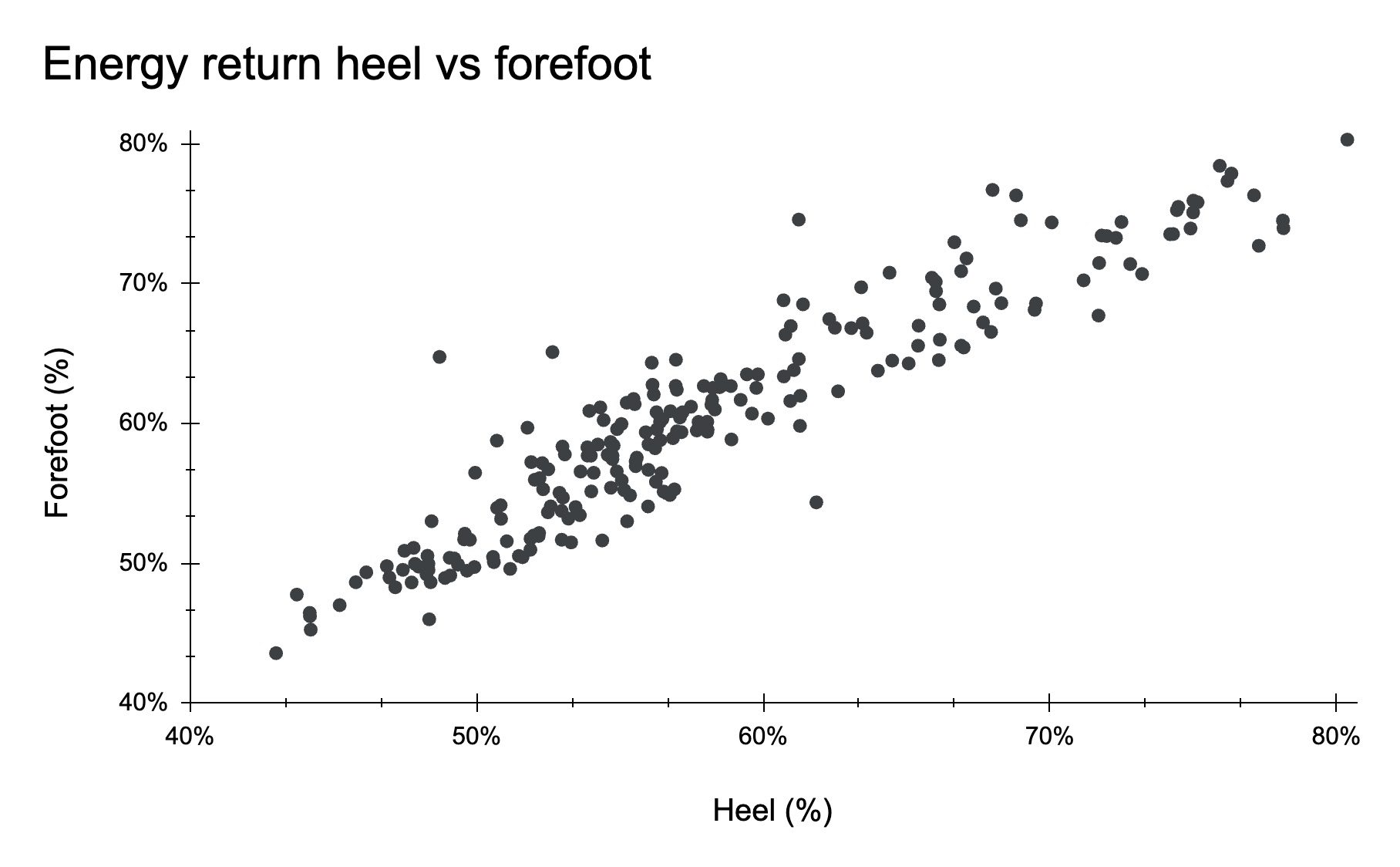
Let's take a look at this chart. It shows a strong correlation between heel and forefoot energy return—when one is high, the other tends to be as well. Also most shoes deliver slightly better energy return in the forefoot, which makes sense given how important push-off is during running.
Interestingly, we also found more variability in the mid-range segment, where some shoes show a noticeable imbalance between heel and forefoot performance. Meanwhile, the top-performing superfoams maintain consistently high energy return across the entire midsole, highlighting how premium materials deliver more uniform rebound for both landing and propulsion phases.
Heel strikers
While it’s not the natural way of running for the human body, heel striking is incredibly common, especially at slower paces. In fact, a broad 2021 meta-analysis found that 79% of runners use a rearfoot strike early in races—and that number climbs to 86% as the run goes on, since fatigue often shifts footstrike patterns.
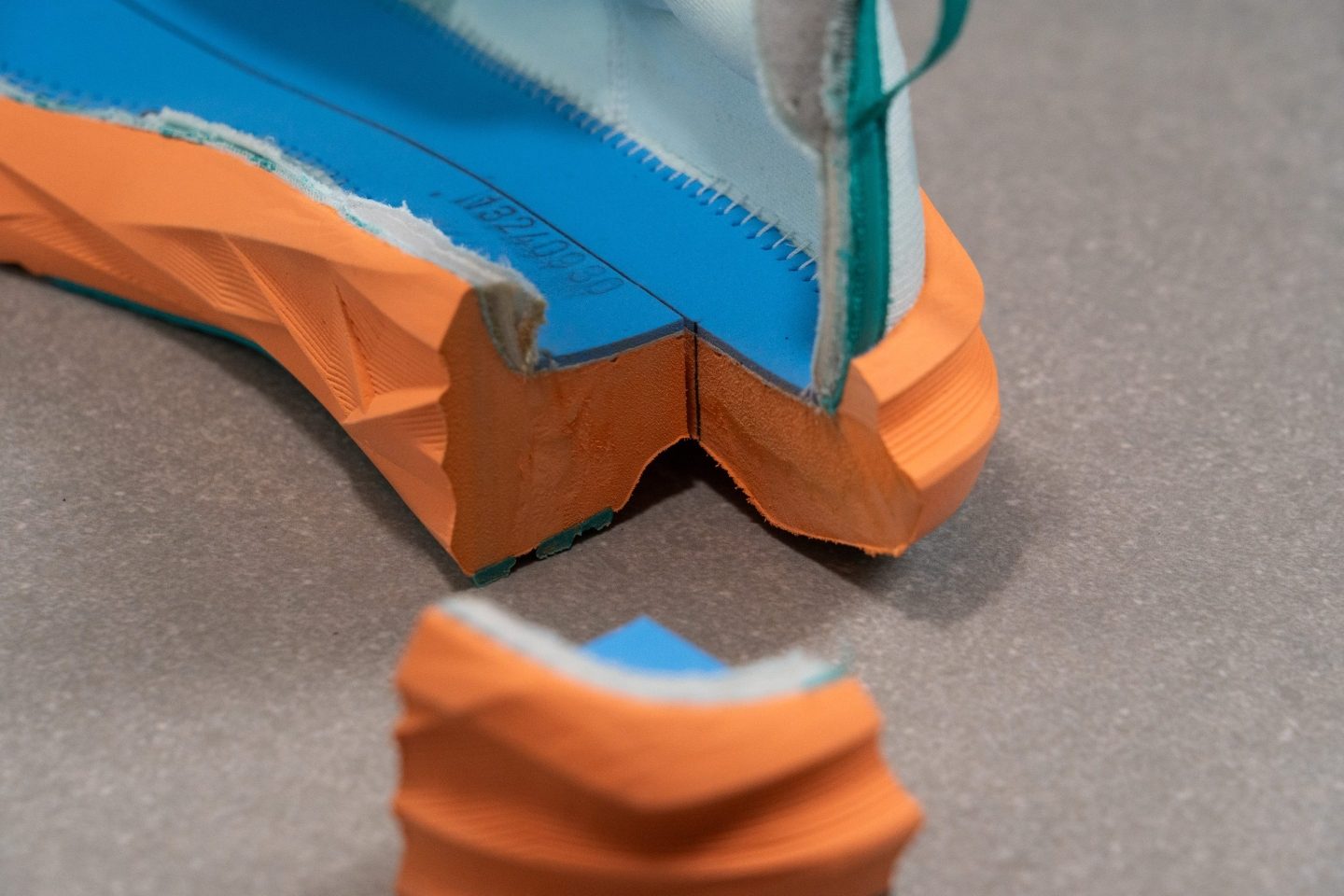
Most high energy-return shoes come with well-cushioned heels, which means they absorb a lot of impact when your foot lands. But what happens to that energy? Ideally, the foam would bounce back and help roll your foot forward. In reality, much of that rebound happens while the foot is still transitioning to midstance, so not all of it helps you move ahead.
That’s why many modern shoes have a noticeable rockered shape, something we also measure in our lab and that we’ve already covered in a guide. You can see this in models like the HOKA Cielo X1 for road running or the Adidas Terrex Agravic Speed Ultra for trail—both designed to convert heel impact into forward momentum rather than letting it sink.
Another key factor is timing and pronation control. When a heel striker lands and compresses the foam, the foot is flexing and the midsole starts to deform. If the foam is too soft, the heel might sink too deep. If the shoe also lacks stability, that can lead to overpronation or a shaky transition. This not only wastes energy through unwanted lateral motion, but it may also increase injury risk. That’s why for heel strikers, a high energy return only matters if the shoe supports a stable heel-to-toe transition.
So, what should you look for in a high-energy-return running shoe? If you’re a heel striker, we strongly recommend choosing a model with a supportive heel counter—rated 3-out-of-5 or higher in our lab—avoiding ultra-soft foams, and probably going for an average or wide heel width.
Two solid examples are the ASICS Superblast 2 and the Adidas Adizero EVO SL—both offer higher-than-average energy return and heel counters that provide added support.
Midfoot / Forefoot strikers
Midfoot or forefoot striking usually results in shorter ground contact and more ankle compliance at landing—since the heel barely touches down, the calf and Achilles absorb much of the impact. Therefore, a good shoe for forefoot runners should work with the natural recoil of the Achilles tendon. High forefoot stiffness, often achieved with a carbon plate, and responsive rebound help “recycle” energy: the Achilles stretches and recoils while the shoe compresses and springs back under the ball of the foot.
This combination of two springs (the Achilles and the midsole) can produce a powerful push-off, especially when the foam delivers high energy return. If the shoe is just soft without rebound and stiffness, some of the Achilles’ stored energy will be wasted.
In other words, if you’re a midfoot or forefoot striker chasing peak performance, high energy return is essential—and high stiffness brings clear benefits too. A rocker isn’t as important in this case. A strong example is the Nike Vaporfly 4: it doesn’t rely on aggressive rocker geometry, yet still delivers top-tier performance thanks to its ZoomX midsole and carbon-fiber plate. In our lab, we measured superb energy return and higher-than-average longitudinal stiffness, making it a standout choice for midfoot and forefoot strikers.
To conclude, midfoot and forefoot striking naturally align with taking full advantage of a shoe’s energy return during push-off, while heel striking depends more on the shoe’s ability to transfer energy smoothly from heel to toe during stance. This means that if you land up front, you can thrive in most running shoes. But if you land farther back, your choice needs to be more precise, and that’s where our lab data can help you.
Which parts of a running shoe influence energy return?
Simply put, everything beneath your foot affects energy return—foam, plate, insole, and outsole all play a role. Meanwhile, the upper sits on top of your foot and doesn’t impact energy return directly, but it can hurt running economy due to added weight.
Foam

The foam in a running shoe is, by far, the most important factor for improving energy return. Beyond how much energy the foam can give back, stack height also plays a key role.
A thin layer of foam bottoms out quickly and stops providing rebound, and this is why most supershoes sit just below 40 mm tall. These superfoams are lightweight and low-density, so they need extra height to deliver their full potential. However, go too thick and you start losing efficiency due to added weight, like it happens with the Adidas Adizero Prime X 2 Strung.
Based on our findings, the ideal stack height to balance energy return and performance is usually around 35 to 40 mm in the heel, and 30 to 35 mm in the forefoot.
Plate
When the supershoe craze kicked off in 2017, many believed the carbon plate acted like a catapult and that it was the true magic behind the performance gains. But that’s not quite right. The plate doesn’t add much energy return by itself compared to the foam, as materials like plastic or carbon fiber don’t provide much bounce on their own.
So, how does it influence energy return? One key role of the plate is to help distribute pressure more evenly across the foam. Without it, your foot presses down unevenly—some areas take more weight than others. With a plate, the force spreads out across a larger surface, allowing the foam to compress and decompress more effectively. That enhances energy return, and it’s one of the reasons plates are essential in supershoes—alongside benefits like added stiffness and improved stability.
Some brands have tried to improve the energy return coming from their plates, like New Balance with the Energy Arc design in the FuelCell SuperComp Elite v4. It features a curvature in the midfoot and heel that supposedly flexes with every stride and “bounces back.” We’re not saying it doesn’t happen, but it’s not a game changer by any means.
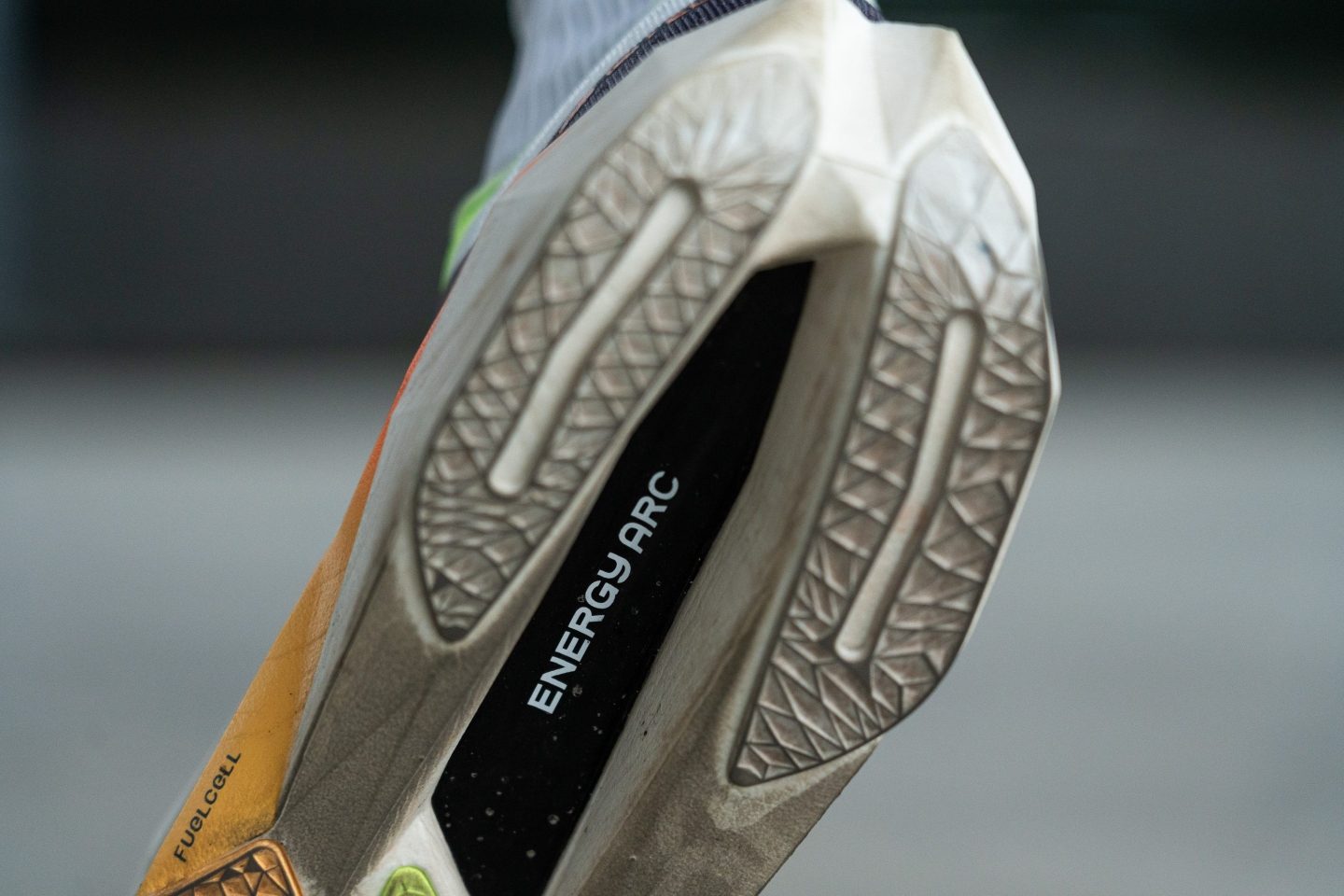
Indeed, an interesting 2019 study tested prototypes with both high and low energy return and bending stiffness. It found that neither high rebound nor increased stiffness alone had a direct impact on running economy. However, other research suggests that combining carbon plates with premium foam reduces the ankle’s positive work, shifting more effort to the knee and hip, and that’s possibly an efficient strategy for seasoned runners.
Insole
The insole is the first layer of foam that touches your foot, so it naturally plays a role in energy return. Surprisingly, even in 2025, many premium shoes still use basic EVA insoles—leaving plenty of room for improvement.
In the case of supershoes, we’ve noticed in our lab that most feature ultra-thin insoles. For instance, the Nike Alphafly 3 uses a 1.9 mm insole, and the HOKA Rocket X 2 comes with a 2.5 mm one. Why so thin? Simple—the thinner the insole, the more room there is for PEBA foam underneath, all while staying within World Athletics’ 40 mm stack limit.
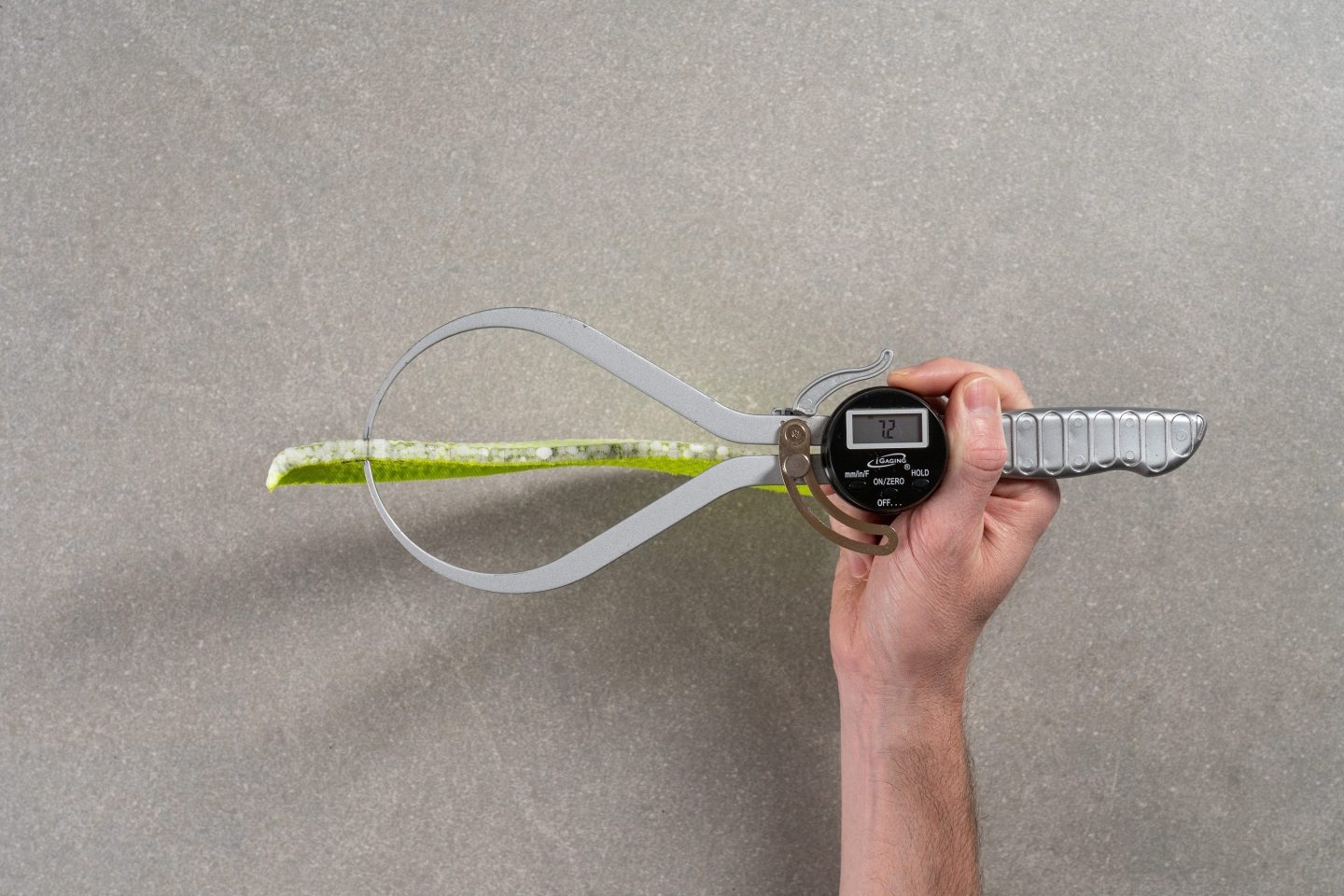
Interestingly, Saucony and Inov8 take a different path. In some of their daily trainers they use thick insoles made of TPU foam to boost cushioning and energy return. It’s a unique and refreshing approach.
And because we’re genuinely curious about everything related to energy return, we ran a small experiment in the lab to understand how much the insole influences this metric. We selected three shoes with very different insoles, the HOKA Mafate 5, Saucony Xodus Ultra 4, and Merrell Nova 4, and swapped their insoles while measuring energy return.
The results really raised our eyebrows. Both the Mafate 5 and the Xodus Ultra 4 lost 9.7% energy return when fitted with the Merrell Nova 4’s basic and cheap EVA insole. Meanwhile, the Nova 4 gained 7% with the Mafate’s insole and an impressive 10.5% with the Saucony’s.
These findings highlight how important a lively insole can be, especially in supertrainers and supershoes where energy return is critical. Those 4 or 5 millimeters of material directly under the foot can make a meaningful difference.
Outsole
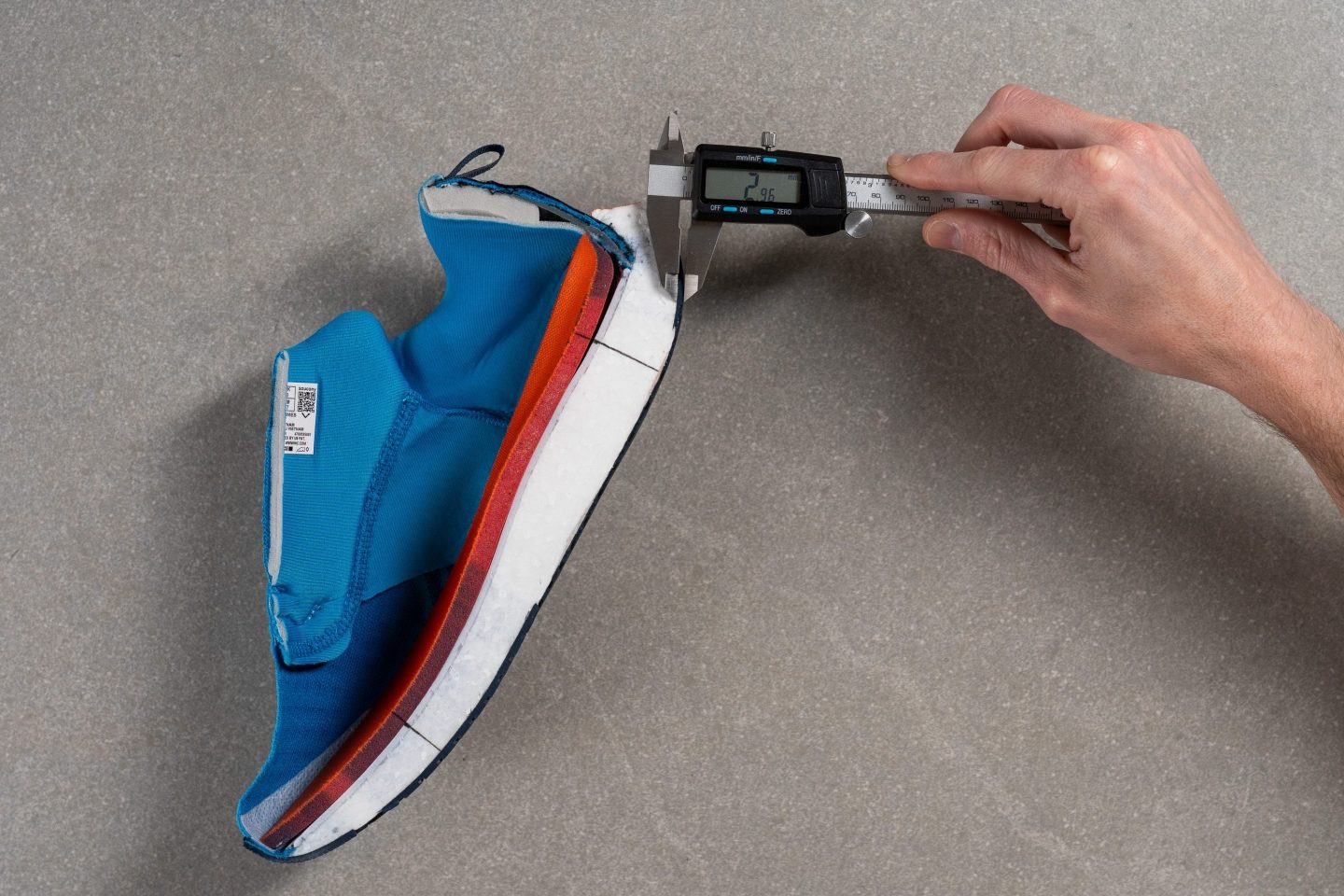
While the insole is the first layer to touch your foot, the outsole is the last to contact the ground. It needs to be much harder to withstand abrasion from pavement, which means it delivers less energy return per millimeter of thickness.
Daily trainers typically use 2 to 4 mm firm outsoles to ensure durability—often lasting over 1,000 km. However, that added thickness and firmness reduce energy return and create a slightly muted ride. In contrast, tempo and race-day shoes usually feature rubber layers to enhance energy return and preserve the natural bounce of the foam—though this comes at the expense of longevity.
To see this in action, here are four examples:
| Shoe | Outsole thickness (mm) | Pace |
| ASICS Gel Kayano 31 | 4.0 | Daily training |
| ASICS Metaspeed Sky Paris | 3.0 | Dainy training |
| Saucony Triumph 22 | 1.5 | Competition |
| Saucony Endorphin Elite | 1.4 | Competition |
When higher energy return is not a priority
After all, it seems that high energy return is the holy grail of running, right? But truth be told, sometimes it just doesn’t matter, and that’s important to understand because it can drive your purchases.
Slow / Recovery runs
As a general rule, the slower your pace, the less important energy return becomes. For example, if you're pushing through a demanding long run, it's crucial to stay on pace and preserve energy for the final stretch. But on an easy jog with a friend or a recovery day, energy return takes a backseat and what really matters is shock absorption.
In other words, think about what your run is meant to do. Is it performance-focused? Then you want energy return. Is it about easing leg stress or aiding recovery? Go for shock-absorbing comfort, maybe even with a soft foam if you're a neutral runner. And good news: we measure shock absorption in our lab, and it’s available for every shoe we test for energy return!
It’s also important to remember that while higher energy return is great for running faster with less effort, it doesn’t really matter during recovery jogs or easy runs. Pace isn’t the priority, as being a few seconds slower or faster per mile won’t affect anything as long as you stay in your zone 1. However, giving your muscles extra shock absorption can definitely help reduce soreness.
| Shoe | Energy Return (% - Heel) | Shock Absorption (SA - Heel) |
| Hoka Cielo X1 2.0 | 75.9 | 160 |
| Nike Pegasus Premium | 67.7 | 155 |
| Salomon Aero Glide 3 | 68.0 | 156 |
| Mizuno Neo Zen | 71.7 | 158 |
| New Balance Balos | 55.1 | 158 |
Remember that high shock absorption is ideal for easy runs, especially when your legs feel wrecked, while high energy return only matters when you're chasing speed. That’s why the Balos isn’t our top choice for a long tempo run. But if you’re keeping the pace relaxed, it’s a solid pick, and clearly a better option than the Cielo X1 2.0, which is stiffer and far less stable despite having more bounce.
Short-distance track races
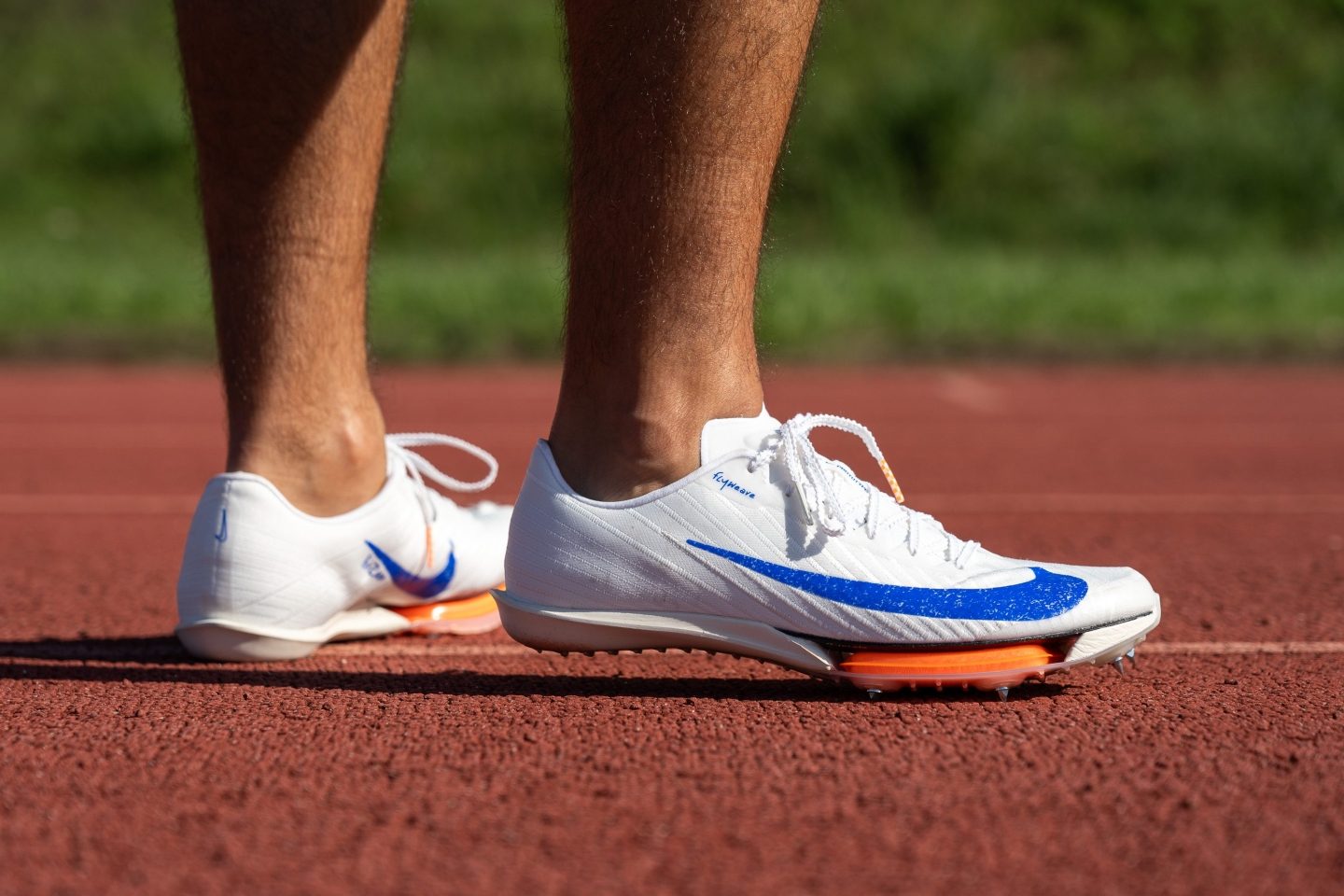
While most modern sprint spikes now feature advanced cushioning like premium foams or Nike’s Air Pods, the truth is they barely impact race-day performance. Just compare how long-distance records have fallen with supershoes, while Usain Bolt’s 100m and 200m records remain untouched without anybody even coming close. Superfoams may offer a marginal benefit in short-distance sprints, but the actual time saved is so small it’s almost negligible.
However, there’s one big advantage: training. Adding around 15 mm of PEBA or A-TPU foam—or even two large Air Pods like the ones we found in our Nike Maxfly 2 lab review—reduces strain on muscles and tendons during workouts. And the more you can train without breaking down, the better your long-term performance.
So, while sprinters won’t see superspikes as game-changers for race day like long-distance runners do with shoes like the Nike Dragonfly 2 Elite, they can still benefit from the leg-saving properties that help support higher training volumes.
How energy return reduces muscle fatigue and improves your fitness

I’m no elite runner by any means, but I have PBs that land inside the sharper end of the amateur spectrum: 35:58 for 10K, 1:18 in the half, and 2:52 in the marathon. According to our calculator (based on almost 35 million race results) that places me around the top 1 or 2% depending on the distance.
But there’s absolutely no chance I would’ve hit those times without modern running shoes built with leg-saving superfoams. In fact, for me, the biggest game changer wasn’t race-day performance, but the ability to rack up more training week after week thanks to reduced muscle fatigue.
Energy return and injury prevention
If you want to avoid next-day soreness after a long run, your shoes need to mix great shock absorption with just the right amount of energy return. That way, your legs don’t get smashed every step. But here’s the thing: if a shoe is too soft and bouncy, it can make your stabilizer muscles work harder just to keep things steady, especially if you bounce too much up and down.
A balanced foam that works with your stride is key. It should feel like a second spring under your feet, helping you stay fresh deep into your run. And if you’re running a lot for an amateur, like 100 kilometers a week or more, that difference really adds up.
In my case, some years ago I ran a half marathon in the Adidas Boston 7 and couldn’t run again for 10 days. A year later, I ran the same effort in the OG Vaporfly 4% and felt fine after two days. Or just think of Kiptum logging up to 300 km a week in Kenya chasing the 2023 Marathon WR. Without today’s superfoams, that would be impossible.
And yes, recent research backs this up. A 2025 study published in Nature (Scientific Reports) showed that modern running shoes reduce joint and muscle loading and promote more efficient strike patterns, which may help prevent overuse injuries.
How foam types impact energy return
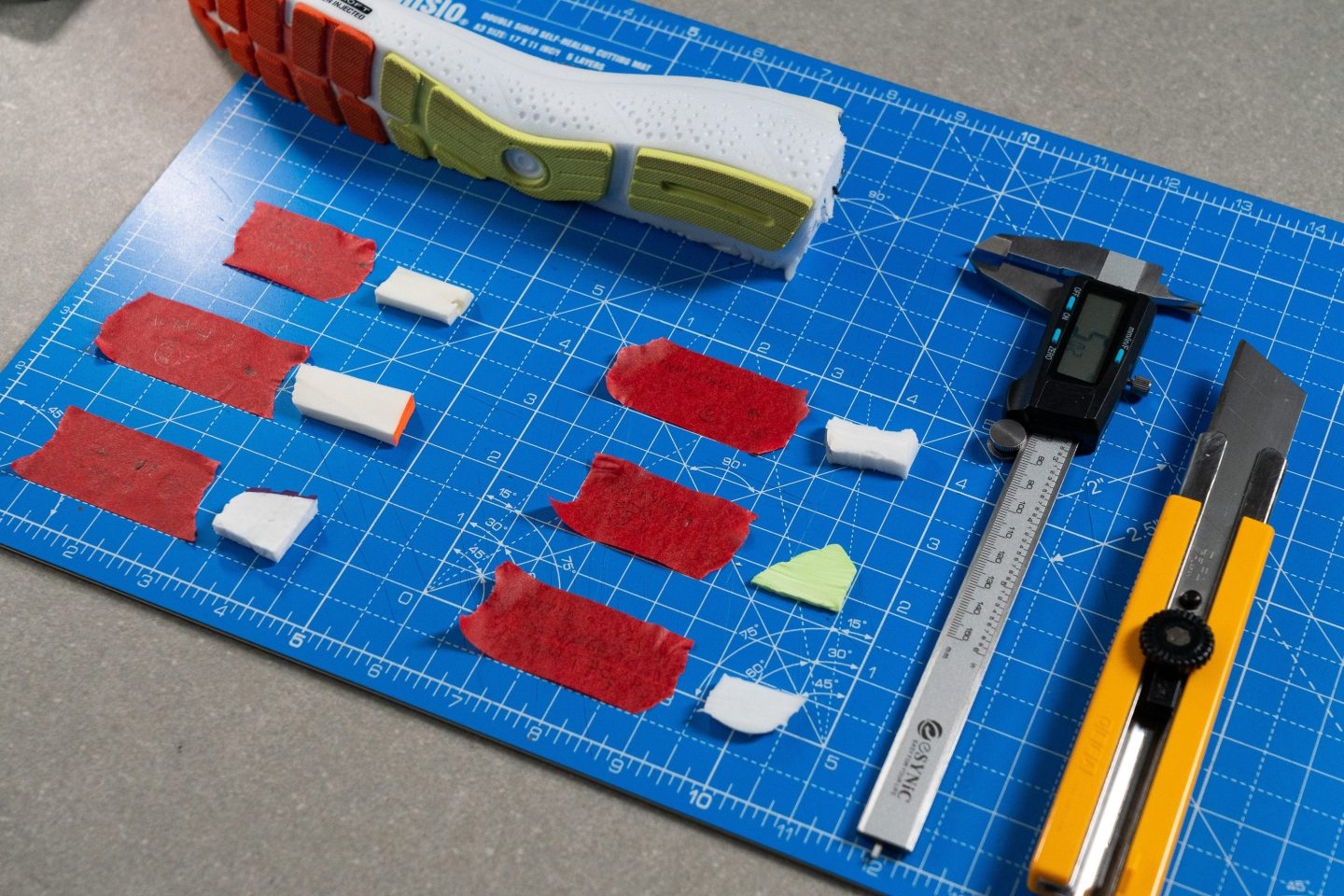
Until 2013, the market was almost entirely dominated by EVA foams. But in 2015, Adidas shook things up with the Ultraboost and its pellet-shaped TPU foam. Then, in 2017, Nike changed the game with the Vaporfly and its PEBA-based midsole. Fast forward to today, and we’re surrounded by a variety of foam technologies.
So we’ve decided to break down each of these materials in terms of energy return—backed by data from our lab.
EVA (Low energy return)
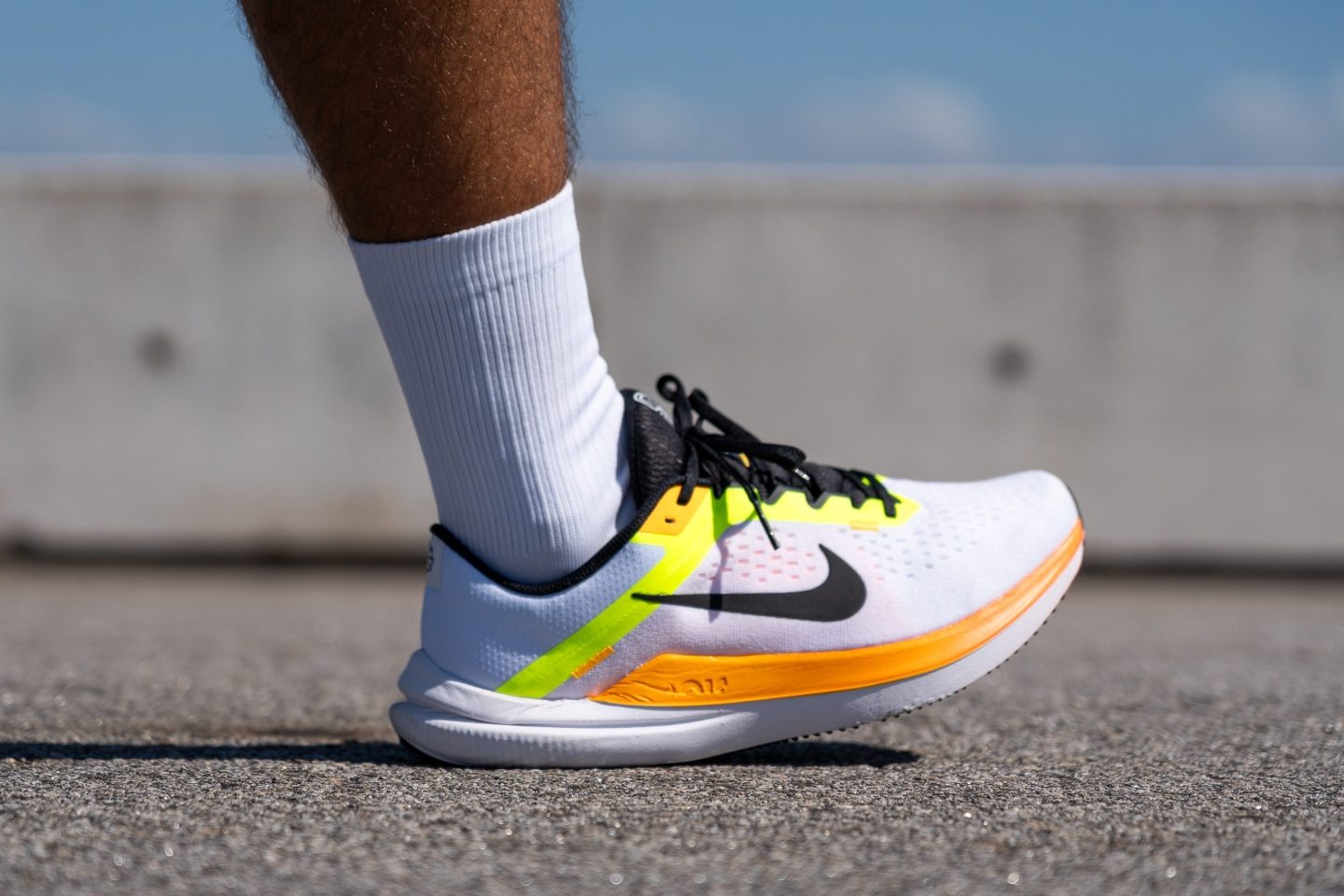
EVA (Ethylene-Vinyl Acetate) is a lightweight, affordable foam used for decades in running shoes. It provides basic cushioning but compresses quickly and lacks rebound. Its energy return is low, and it breaks down faster under load, which is why newer materials have largely replaced it in performance models.
| Shoe | Foam | Energy return (% - Heel) | Energy return (% - Forefoot) |
| ASICS Gel Nimbus 27 | EVA + OBC | 47.7 | 48.6 |
| Nike Winflo 10 | EVA | 54.4 | 51.6 |
| New Balance More v5 | EVA | 52.3 | 57.2 |
| Hoka Clifton 10 | EVA | 53.6 | 56.6 |
Supercritical EVA / EVA blends (Low/Medium energy return)

Skechers did a great job by creating the first supercritical EVA midsole, which provides (most times) improved energy return and reduced weight, making the shoe faster overall while still relying on EVA. We’ve seen some shoes where energy return doesn’t improve, but still, weight goes really down and that alone is worth it. Hence, at the same price, it’s always better to go supercritical EVA than regular EVA.
We’ve also started seeing EVA blends on the market, where brands mix low-energy-return EVA with high-rebound materials like PEBA. New Balance has done this successfully in models like the FuelCell SuperComp Trainer v3 and the FuelCell Rebel v4.
| Shoe | Foam | Energy return (% - Heel) | Energy return (% - Forefoot) |
| Mizuno Neo Vista | Supercritical EVA | 56.9 | 55.3 |
| Hoka Mach 6 | Supercritical EVA | 65.4 | 67.0 |
| New Balance Rebel v4 | EVA / PEBA blend | 63.1 | 66.8 |
| New Balance Trainer v3 | EVA / PEBA blend | 53.6 | 56.6 |
TPE (Low/Medium energy return)

TPE stands for “Thermoplastic Elastomer” and is a rubber-like plastic blend offering moderate flexibility and rebound. While it’s more responsive than EVA, it's less bouncy and less commonly used in high-performance shoes. Its value lies in cost-effectiveness and balanced performance across a variety of mid-range training models.
| Shoe | Foam | Energy return (% - Heel) | Energy return (% - Forefoot) |
| Nike Pegasus 41 | TPE / EVA blend | 55.5 | 61.4 |
| Nike InfinityRN 4 | TPE / EVA blend | 61.3 | 59.8 |
| PUMA MagMax Nitro | TPE | 55.5 | 57.3 |
| Altra Escalante 4 | TPE | 58.5 | 62.6 |
TPU (Medium/High energy return)
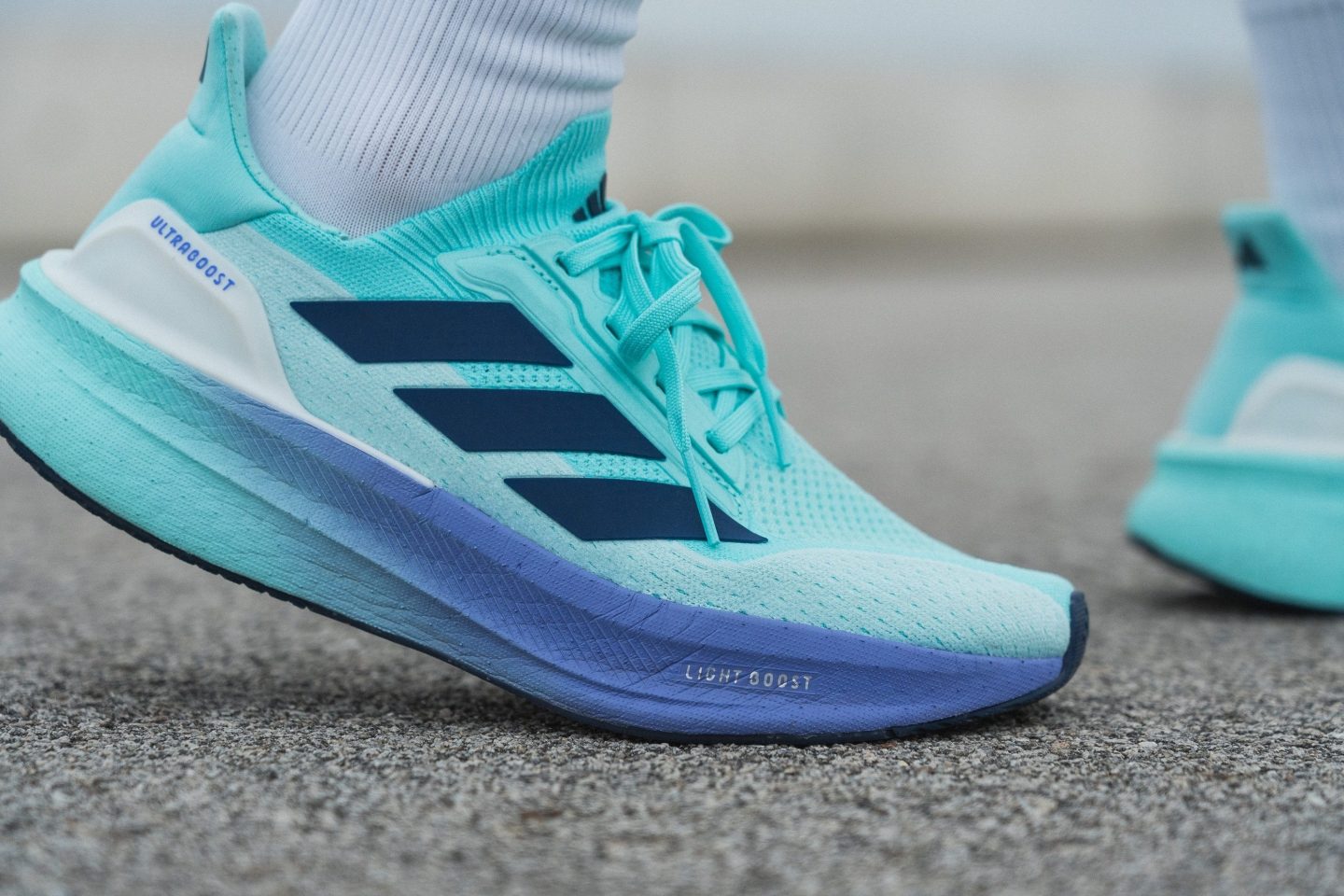
TPU (Thermoplastic Polyurethane) is a denser, more durable foam known for good bounce and strong impact resistance. Often used in bead form (like Adidas Boost), it returns more energy than EVA but adds weight. It performs better in colder temperatures and holds up longer under heavy training mileage.
| Shoe | Foam | Energy return (% - Heel) | Energy return (% - Forefoot) |
| Adidas Ultraboost 5X | TPU | 66.0 | 70.1 |
| Adidas Ultraboost Light | TPU | 66.7 | 73.0 |
| Altra Torin 8 | TPU / EVA blend | 58.2 | 61.7 |
| Adidas Pureboost 5 | TPU | 67.7 | 67.2 |
TPEE (High energy return)
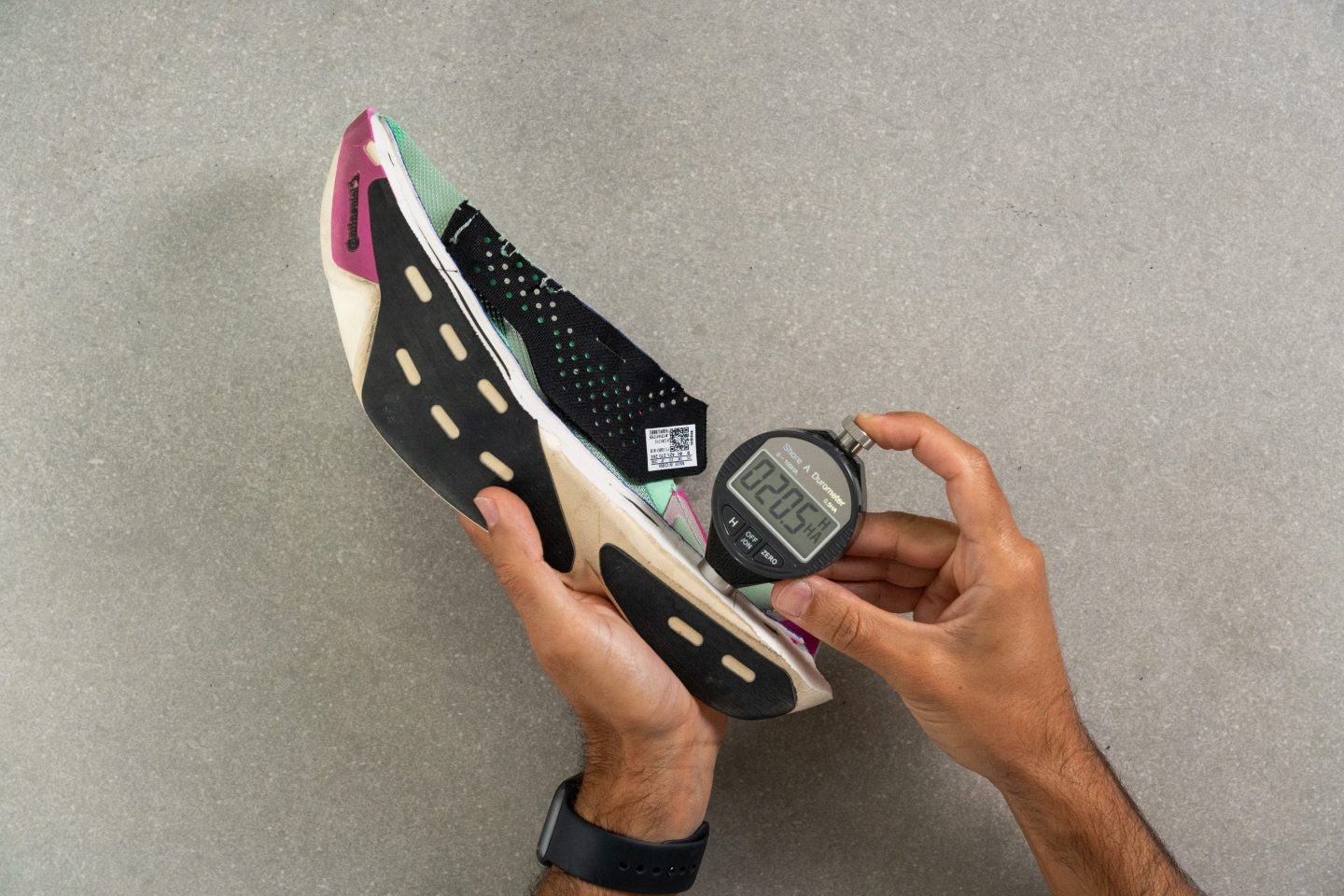
TPEE (Thermoplastic Polyester Elastomer) became widely known through Adidas and its Lightstrike Pro foam—the brand’s answer to Nike’s ZoomX. TPEE improves on regular TPE with greater elasticity, strength, and fatigue resistance, delivering high energy return and reliable performance across various temperatures.
It’s impressively bouncy and remarkably durable, a rare combo in running shoes. Plus, it’s cheaper to produce than PEBA, allowing Adidas to lower price points, like they did with the highly successful EVO SL. This table also highlights how mixing in a non-premium foam layer significantly cuts down energy return compared to using a full-length premium midsole.
| Shoe | Foam | Energy return (% - Heel) | Energy return (% - Forefoot) |
| Adidas Adios Pro 3 | TPEE | 75.0 | 75.1 |
| Adidas EVO SL | TPEE | 74.3 | 73.5 |
| Adidas SL2 | TPU / TPEE | 56.1 | 65.4 |
| Adidas Boston 13 | TPU / TPEE | 63.4 | 69.7 |
PEBA (High energy return)
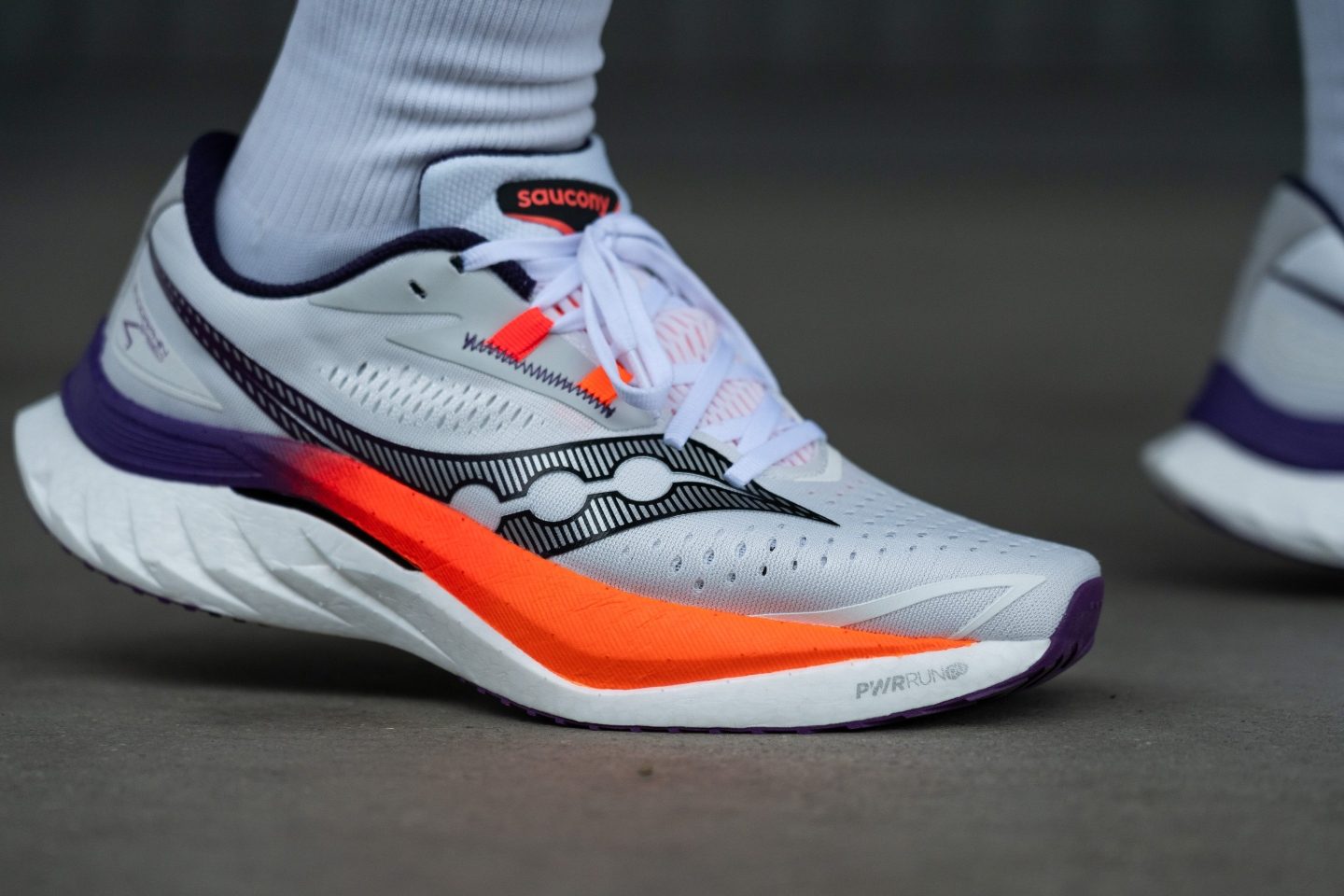
PEBA has changed the running shoe world since 2017, and it has been the material of choice for most supershoes since then. It offers exceptional bounce, good durability, and retains its properties in extreme conditions. And luckily for us, costs have come down a lot, so brands like Nike, Saucony or Adidas are using PEBA in their training shoes too.
| Shoe | Foam | Energy return (% - Heel) | Energy return (% - Forefoot) |
| Nike Vaporfly 4 | PEBA | 78.1 | 74.5 |
| Saucony Endorphin Speed 4 | PEBA | 72.0 | 73.4 |
| Adidas Supernova Rise 2 | PEBA | 69.5 | 68.1 |
| ASICS Superblast 2 | PEBA / EVA | 73.2 | 70.7 |
A-TPU (High energy return)
The latest major innovation is aliphatic TPU, a next-gen version of TPU treated with supercritical gas processes to boost energy return and cut weight. It delivers a springy, responsive ride and, in our experience, matches PEBA in performance. It also offers better foam fatigue resistance—an edge that matters in marathon racing. So far, brands like PUMA and Adidas have successfully integrated this foam into their latest supershoes, and we’re confident it will start replacing PEBA in many upcoming top-tier models.
PUMA even ran a study with Wouter Hoogkamer to show that their newest supershoe delivered a ~3% improvement compared to any other model. So yes, A-TPU seems to be the real deal.
| Shoe | Foam | Energy return (% - Heel) | Energy return (% - Forefoot) |
| Adidas Adios Pro 4 | PEBA | 80.4 | 80.3 |
| PUMA Deviate Nitro Elite 3 | A-TPU | 77.1 | 76.3 |
| PUMA Fast-R Nitro Elite 2 | A-TPU | 68.0 | 76.7 |
Does cold weather kill energy return?
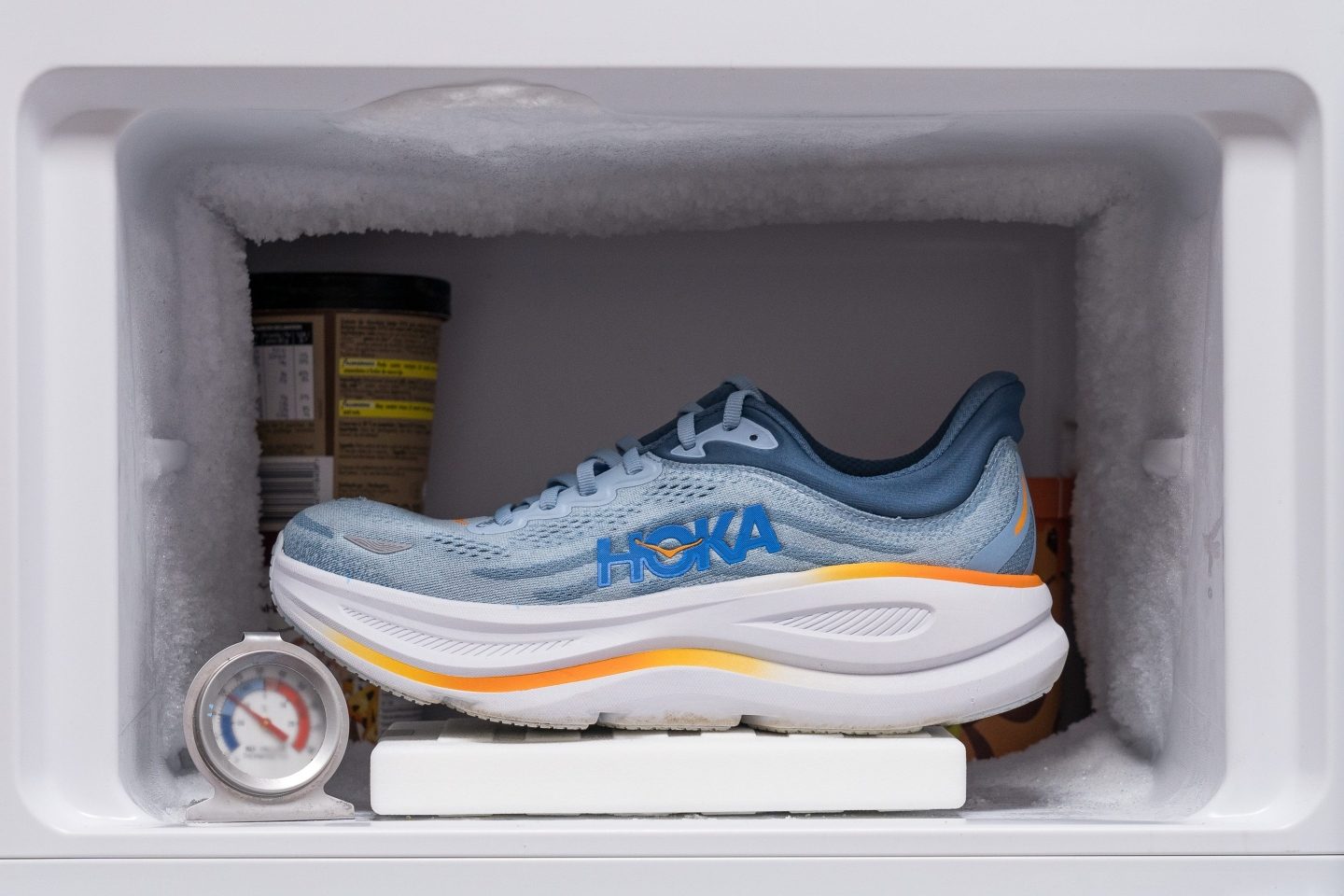
If you’ve been following RunRepeat for some time, you probably know we’ve long tested how cold affects midsole softness by placing shoes in the freezer and measuring softness before and after. We even have a full guide on how temperature impacts running shoes. In short, EVA-based foams tend to stiffen dramatically, while premium foams retain their softness much better. But what about energy return?
To find out, we tested 10 running shoes by cooling them for 35 minutes at -15ºC and then measuring energy return before and after the nap in the freezer. The results mirrored what we see with softness:
| Shoe | Foam type | Energy return (%) | Energy return (% - Cold) | Change (%) |
| Adidas Adios Pro 4 | Premium | 80.3 | 79.3 | -1.3 |
| Brooks Hyperion Elite 4 PB | Premium | 71.8 | 66.2 | -7.8 |
| Saucony Endorphin Elite | Premium | 74.5 | 71.7 | -3.7 |
| Nike Vaporfly 4 | Premium | 74.5 | 72.0 | -3.4 |
| ASICS Metaspeed Sky+ | Premium | 74.4 | 68.3 | -8.1 |
| ASICS Gel Kayano 31 | Standard | 50.3 | 32.9 | -31.5 |
| Hoka Bondi 9 | Standard | 60.3 | 37.2 | -38.3 |
| Nike Pegasus 41 | Standard | 61.4 | 43.5 | -29.1 |
| Brooks Adrenaline GTS 24 | Standard | 57.7 | 42.3 | -26.7 |
| Adidas Galaxy 6 | Standard | 51.0 | 27.7 | -45.7 |
As shown in the table above, premium foams like PEBA and A-TPU held up remarkably well, maintaining much of their energy return. In contrast, standard foams saw a big drop. Our takeaway is simple: if you run in cold conditions, investing in shoes with premium foams pays off even more than it does for runners in warmer climates.
Elites vs. Recreational runners: Who gains more from supershoes?
There’s a paradox in how different runners benefit from high-energy-return shoes. Elite athletes generally gain more in terms of running economy—thanks to higher forces, faster cadence, and better foam compression that fully activate the superfoam and carbon plate. Supershoes are tuned for the mechanics of fast running, so they deliver a higher percentage improvement in speed and efficiency for this group.
Meanwhile, back-of-the-pack runners may not trigger the same level of rebound due to lower ground reaction forces and longer ground contact times. However, they still benefit from supershoes, and can sometimes see bigger total time savings simply because they’re out on the course longer. Let’s break it down!
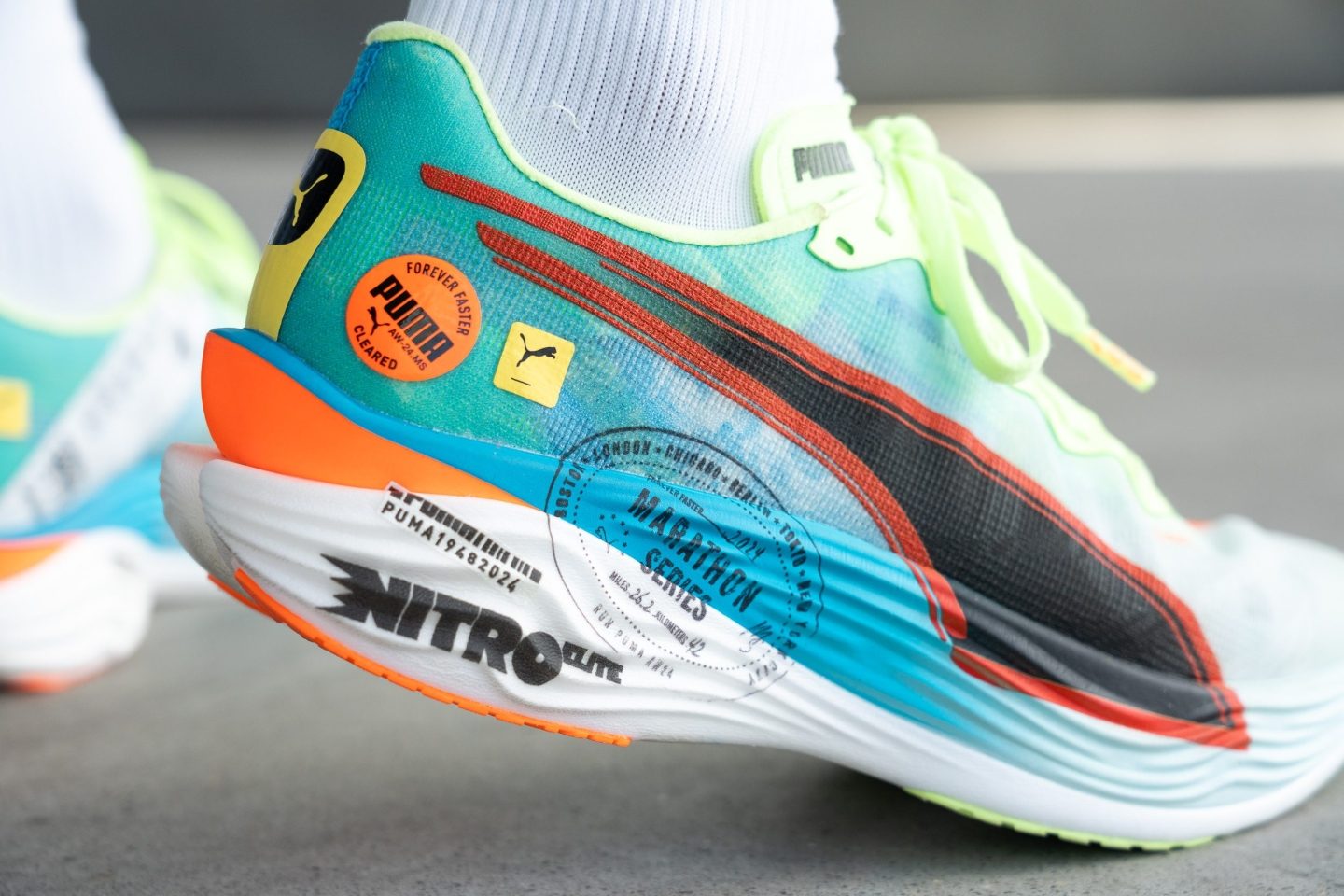
Runner A has a PB of 2:20:00 and improves by 4%—now clocking 2:14:24. Runner B has a PB of 4:20:00 and gains only 3%—now finishing in 4:12:12. Despite the smaller relative improvement, Runner B actually cuts more total time (~8 minutes vs. ~6 minutes).
So while slower runners may save more minutes, the efficiency gain is usually smaller. Supershoes benefit both groups, but they offer more raw performance for elites and greater endurance support for recreational runners, even despite the reduced aero drag experienced by slower individuals.
It’s also interesting to note that, according to a 2023 study, world-class runners showed highly variable results—ranging from an 11.3% drawback to an 11.4% benefit—while amateurs consistently improved, with average gains up to 5%. In our view, this confirms the idea that elite runners don’t always respond better but there are super-high responders, while amateurs see more modest gains in general.
However, it’s clear that performance gains depend not only on speed but also on biomechanics and how closely a runner’s form aligns with the shoe’s design. In fact, some elites are already testing multiple models (and brands!) in the lab to find the best match for their running economy, just like Clayton Young did with the Metaspeed prototypes during his Boston Marathon buildup.
Does energy return work the same for men and women?
There isn’t strong scientific evidence showing that men and women inherently benefit differently from energy return in running shoes—but there are clear biomechanical and physical differences that affect how each experiences it. And shoes can also vary between genders, as we’ve shown in our dedicated guide on the topic.
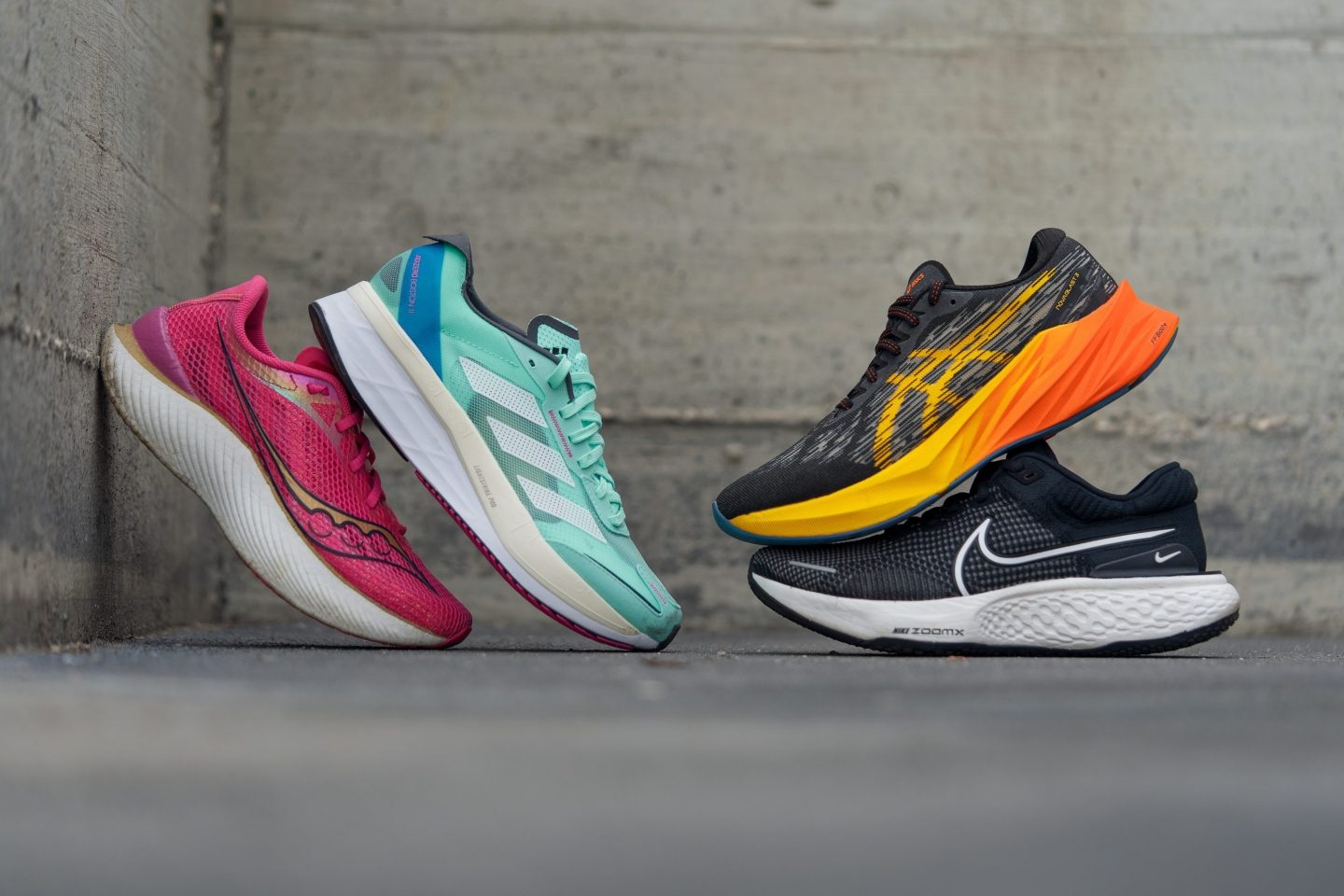
Men, on average, are heavier and apply more force to the shoe with every step. This greater force compresses superfoams more effectively and activates the carbon plate or Energy Rods to a fuller extent. As a result, men may reach the “sweet spot” for energy return more easily, especially in stiffer shoes.
Women, being lighter, often don’t compress the midsole as much, meaning they might not get the same rebound effect from the exact same shoe. Also, due to smaller shoe sizes, plates are shorter and geometrically stiffer. However, some brands address this by using thinner plates in smaller sizes, like Brooks.
Biomechanics also play a role. Women tend to have wider hips relative to their knees, which can increase pronation due to the Q-angle. In ultra-stiff or narrow shoes, this may reduce efficiency and prevent full energy return, as there’s some lateral bias.
Methods to measure energy return in running shoes
There are multiple ways to measure energy return in running shoes, and since there’s no standardized method across the industry, each company—including ours—chooses based on its preferences, needs or budget constraints.
ASTM F1976
This is the most widely adopted method for testing energy return and shock absorption, commonly used in laboratories and universities worldwide. And it’s the one that we’ve chosen at RunRepeat. It’s a gravity-driven protocol where an 8.5 kg mass is dropped from 50 mm, which generates a total energy input of 5 joules. The system captures the full force/displacement curve to compute energy return as a percentage.
Here’s how we do it: We follow World Athletics stack height measurement zones, testing at 12% from the heel (heel zone) and 75% from the heel (forefoot zone). Each location is tested with 30 drops: the first 25 repetitions condition the foam, simulating real-world break-in, while repetitions 26–30 are averaged to get final results. We maintain a 2-second interval between drops to ensure consistency.
After consulting world-class researchers and shoe brands, we selected this method because it closely aligns with how runners experience cushioning and bounce underfoot.
Universal Testing Machine (UTM)
Uses programmable actuators to apply repeated loads, mimicking running steps. While it can simulate fatigue and temperature effects, it requires extremely precise calibration to match real footstrike speed, which sometimes leads to inconsistent results.
In vivo force sensors
These are used during actual treadmill runs to record ground reaction forces. They’re great at capturing the full interaction between runner and shoe, but the downside is they can’t isolate the shoe’s individual contribution.
Drop ball test
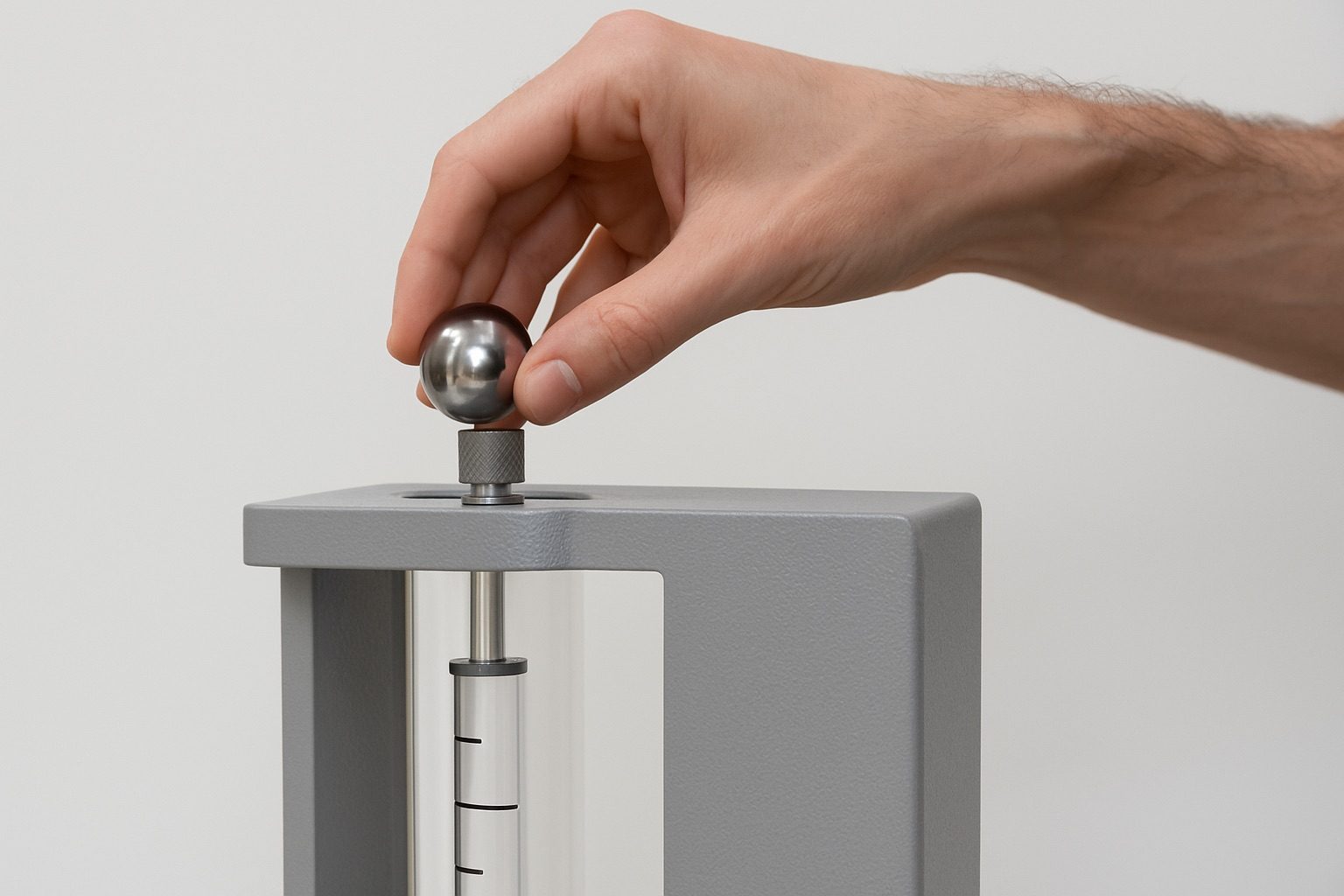
You’ve probably seen this one on Instagram or YouTube, where runfluencers and youtubers drop a ball on the midsole to measure bounce height. While homemade versions are unreliable, there are advanced machines that can do it properly. However, it depends heavily on test setup, is easy to manipulate, and can produce misleading results due to factors like curved midsoles and directional rebound.
Others
Some brands and research labs have created their own testing setups, like Hoogkamer et al., who compared the Nike Vaporfly prototype with the Nike Streak and the Adidas Adios Boost 2 in their famous study.
As you can imagine, the big issue is that without a standardized approach, data from different labs can’t be directly compared. For example, in our lab, we’ve tested hundreds of shoes using the same setup, so you can trust side-by-side comparisons. But if one study tests 8 shoes with one method and another uses a different machine on 12 others, comparing the results is basically meaningless. However, at RunRepeat, you can compare hundreds of shoes tested in exactly the same environment and with the same machine. Sounds cool, huh?
Limitations of energy return tests

No matter which protocol is used, energy return tests are far from perfect. Each method has its own limitations, and we’ve simply chosen the one with the fewest constraints based on lab consistency and biomechanical relevance.
Take the UTM method, for example—it often overestimates energy return compared to real-world running. That’s because it applies greater and more uniform loads than what most runners generate with each stride. Another issue is that it doesn’t distinguish between rebound energy and the energy required for the midsole to recover its shape, which is a key factor. In fact, with the ASTM F1976 protocol we use you can find that up to 35% of the total energy output is spent just returning the midsole to its original form. Crazy.
Still, the biggest limitation isn’t the test but the sport itself. Running is an incredibly complex movement with endless variation. Unlike cycling, where you can precisely measure pedal force, running involves different foot shapes, pronation angles, and landing patterns. As a result, energy return numbers tell us how much bounce a shoe delivers in a controlled setting, but don’t assume that value will translate equally for every runner out on the road.
In fact, some studies like this one have found that the same supershoe creates “responders” and “non‑responders”. Yes, running seems to be a simple sport, but it’s incredibly complex under the hood.
When energy return (might) backfire

The most typical issue is that high energy return often comes with a soft midsole. If you're a heel striker, that can lead to a sinking sensation, even with a rockered design. A good example is the New Balance Fresh Foam X Balos: great for midfoot and forefoot strikers, but not ideal for those landing farther back.
Another reason energy return might backfire is thickness. To get maximum bounce, foams need volume, and that usually means a super-tall stack. But with that comes added weight, instability, or both. For some runners, it might be smarter to choose a lighter, more nimble shoe with lower energy return over a bulky high-stack model for training runs.
There’s one more thing. When you run, the midsole compresses under load and then rebounds—but not all of that energy goes into propelling you forward. Part of it is spent just restoring the shoe’s shape as we already explained before. So if a shoe is too thick or too slow to rebound, you might already be toeing off before it finishes bouncing back. In that case, the timing’s off—and all that energy ends up going nowhere.
And energy return isn’t everything
As Martyn Shorten noted in his amazing 2024 paper, most of the energy “returned” by a shoe simply helps it spring back into shape rather than pushing you forward. That’s why energy return alone can’t explain why supershoes are so effective, it's their ultra-light construction and ultra-stiff geometry that elevate performance.
In other words, higher energy return is almost always a plus, but it’s just one piece of the performance puzzle, not the whole picture.
Budget constraints and the energy return dilemma
Another situation where energy return can backfire is when you're working with a limited budget. Premium foams with top-tier energy return can be significantly more expensive than standard EVA, and that difference shows up in the final shoe. For example, if your budget is around $150, you’ll likely need to choose two of these three: build quality, energy return, or a comfortable upper. You can’t have it all.
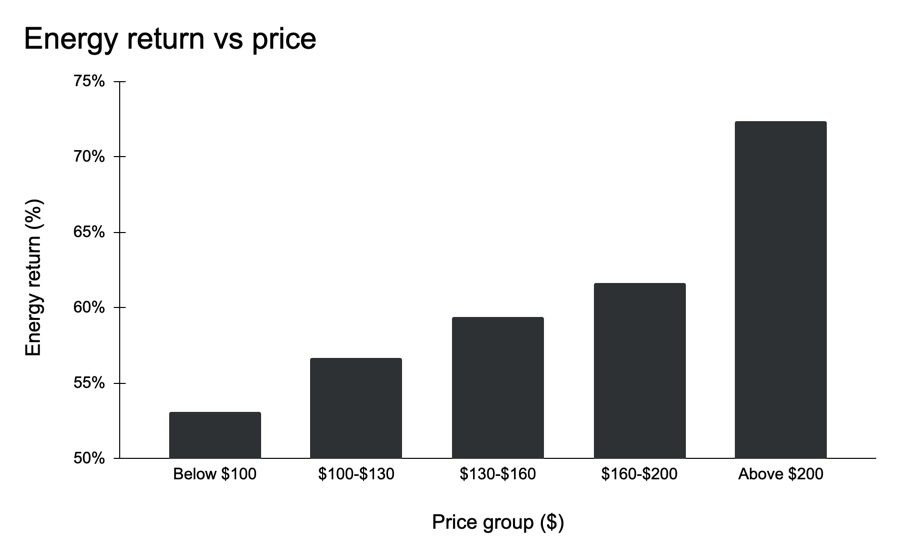
Take the Adidas Adizero EVO SL, for example. It shook up the market by offering full-length Lightstrike Pro (74.3% energy return) at a highly competitive price—but it comes with a basic upper and laces. On the flip side, the HOKA Clifton 10 is also well priced and features an ultra-comfortable upper, but only delivers 52.3% energy return in the heel.
So, when your budget isn’t unlimited, prioritization becomes key, and we think that energy return shouldn’t always top the list. If you’re buying a shoe for daily use or recovery runs, chasing bounce probably makes no sense. It’s like buying a stiff, gas-hungry sports car just to drive on the highway.
Barefoot / Minimalist shoe lovers
From a barefoot or minimalist running point of view, high energy return shoes aren’t always a good thing. One of the biggest issues is the loss of ground feel, as most high-energy-return shoes are quite thick. Minimalist runners value that direct connection with the surface to adjust their stride naturally, improve posture, and stay light on their feet. But when the midsole is thick and bouncy, it blurs that feedback, making it harder to run with awareness and precision.
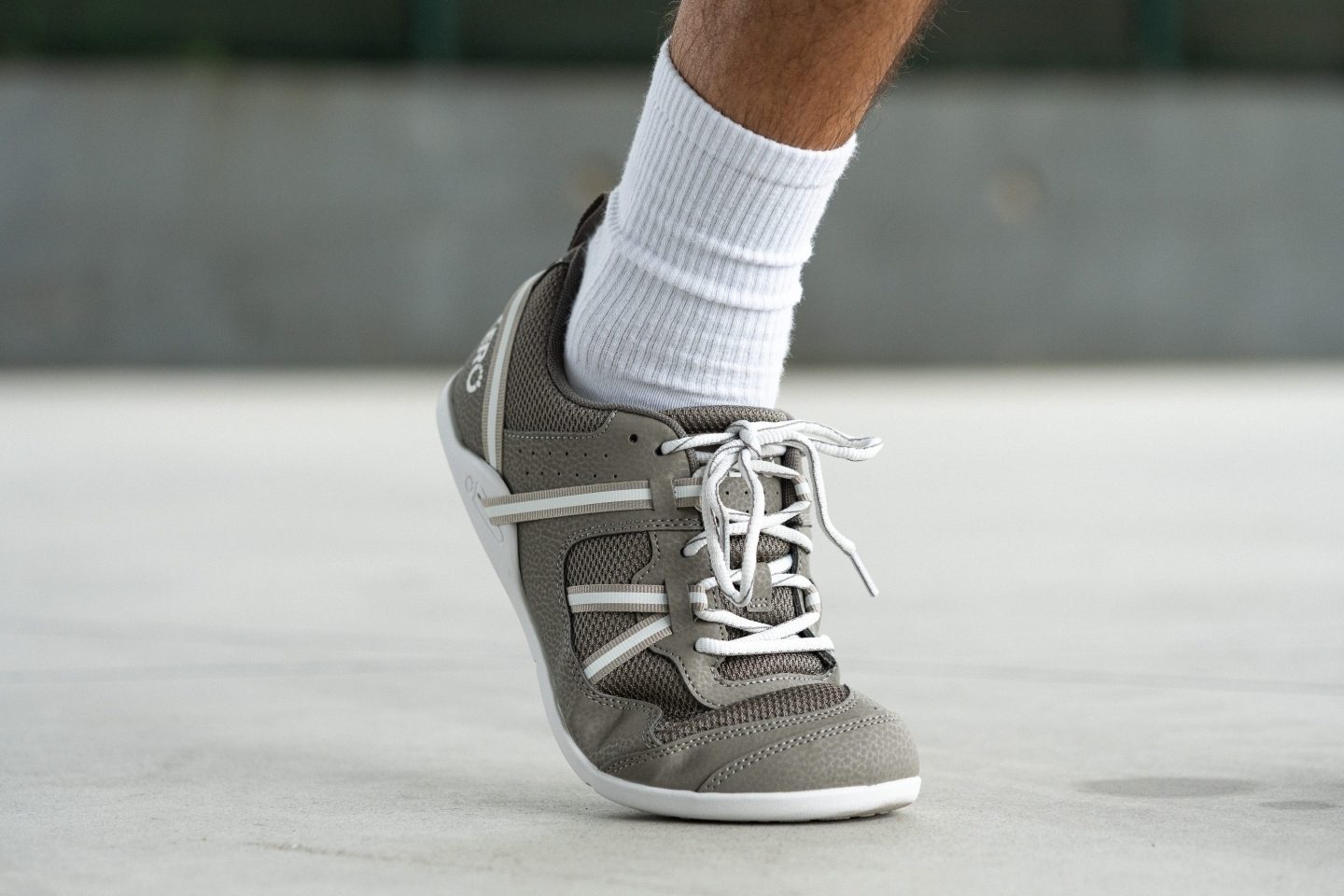
Another concern is that these foams can change your natural mechanics. They often encourage more vertical movement and can lead to a heavier heel strike—something barefoot running tries to avoid. Instead of flowing into a smooth midfoot or forefoot landing, you might end up bouncing too much or overstriding.
Also, super-cushioned shoes tend to do a lot of the work for you. That might sound nice at first, but over time, your foot and ankle muscles don’t get the same stimulus they would in a flatter, firmer shoe. The result? Weaker stabilizers and a loss of that natural strength and control that minimalist runners build over time.
So while high energy return feels great underfoot and is amazing for chasing times and logging more miles, it goes against many of the principles that barefoot runners follow.
The fun factor matters!
Some shoes feel like they “pop” you forward, creating a playful, energetic sensation that can make running feel easier and more enjoyable. And at the end of the day, chances are 99.9% that if you’re reading this, you’re not elite, and I encourage you to value fun over performance—it’s much more worthwhile from a long-term standpoint. And yes, I'm speaking from firsthand experience.
As you can imagine, the fun factor usually comes tied to a huge placebo effect. Bouncy shoes often give runners a confidence boost, encouraging them to push a little harder or run a bit longer simply because the experience feels satisfying.
Interestingly, research shows that runners often perform better when they believe their shoes are high-tech or energy-saving—even when the shoes are actually identical. Visibly bouncy shoes with thick, compliant soles tend to amplify this effect. Compared to soft shoes that simply feel plush and sink underfoot, bouncier models return more energy and keep the ride more dynamic. In contrast, plush-but-flat shoes may offer comfort but lack that spring-loaded sensation that makes each step feel… fun!
Energy return in trail running shoes
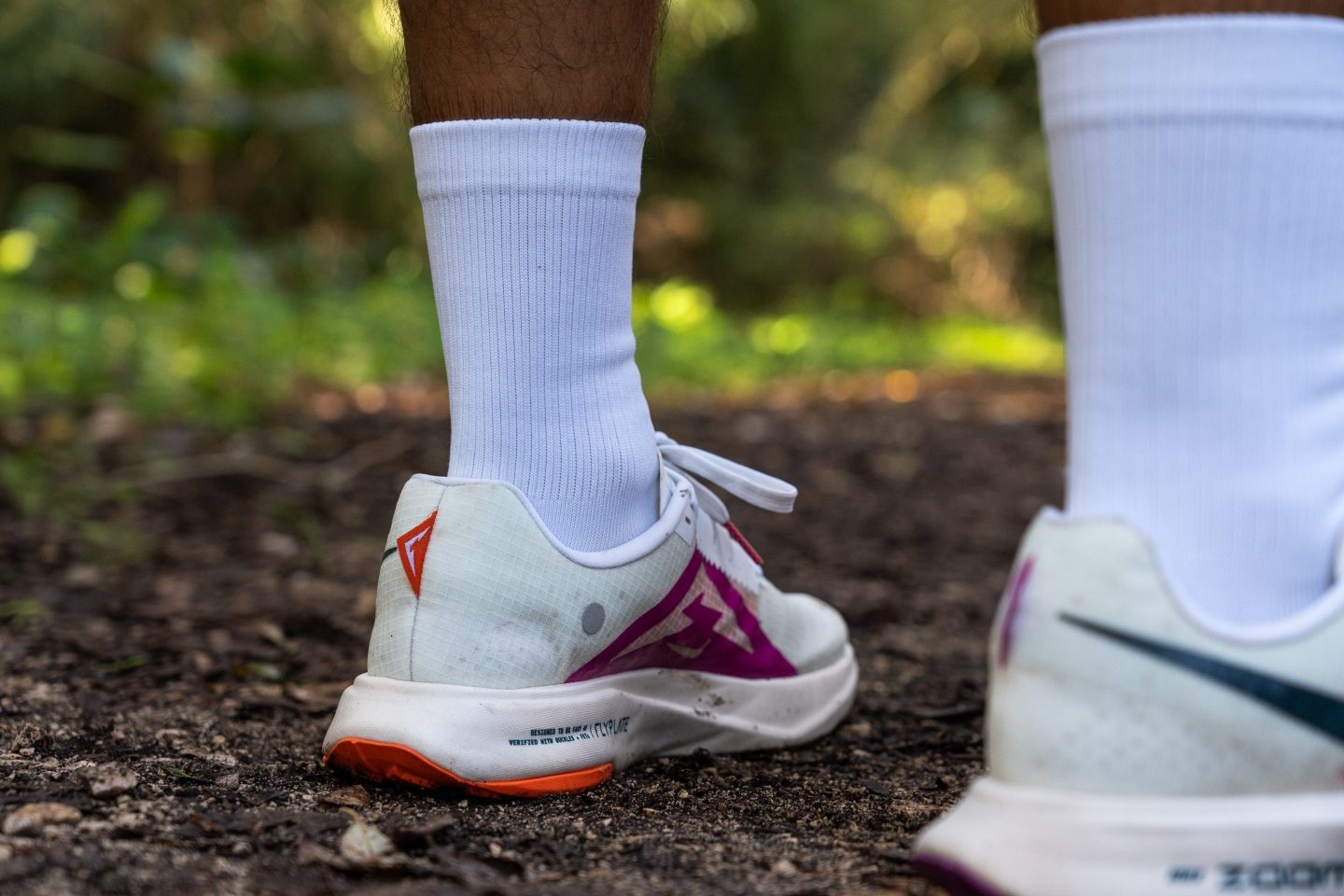
We’ve already shown that energy return is a key factor for road running shoes—but what about trail shoes?
We believe it still matters, though to a much lesser extent. Most trail runs are more laid-back, with runners prioritizing enjoyment over chasing times. For this reason, shock absorption becomes more valuable, especially in ultra-distance efforts.
Interestingly, the foams used in trail shoes are often the same as those in road models, but we found that the average energy return is lower. Why does that happen? The answer lies in the outsole design—trail shoes have thicker, lug-covered outsoles that offer almost no rebound and drastically reduce bounce.
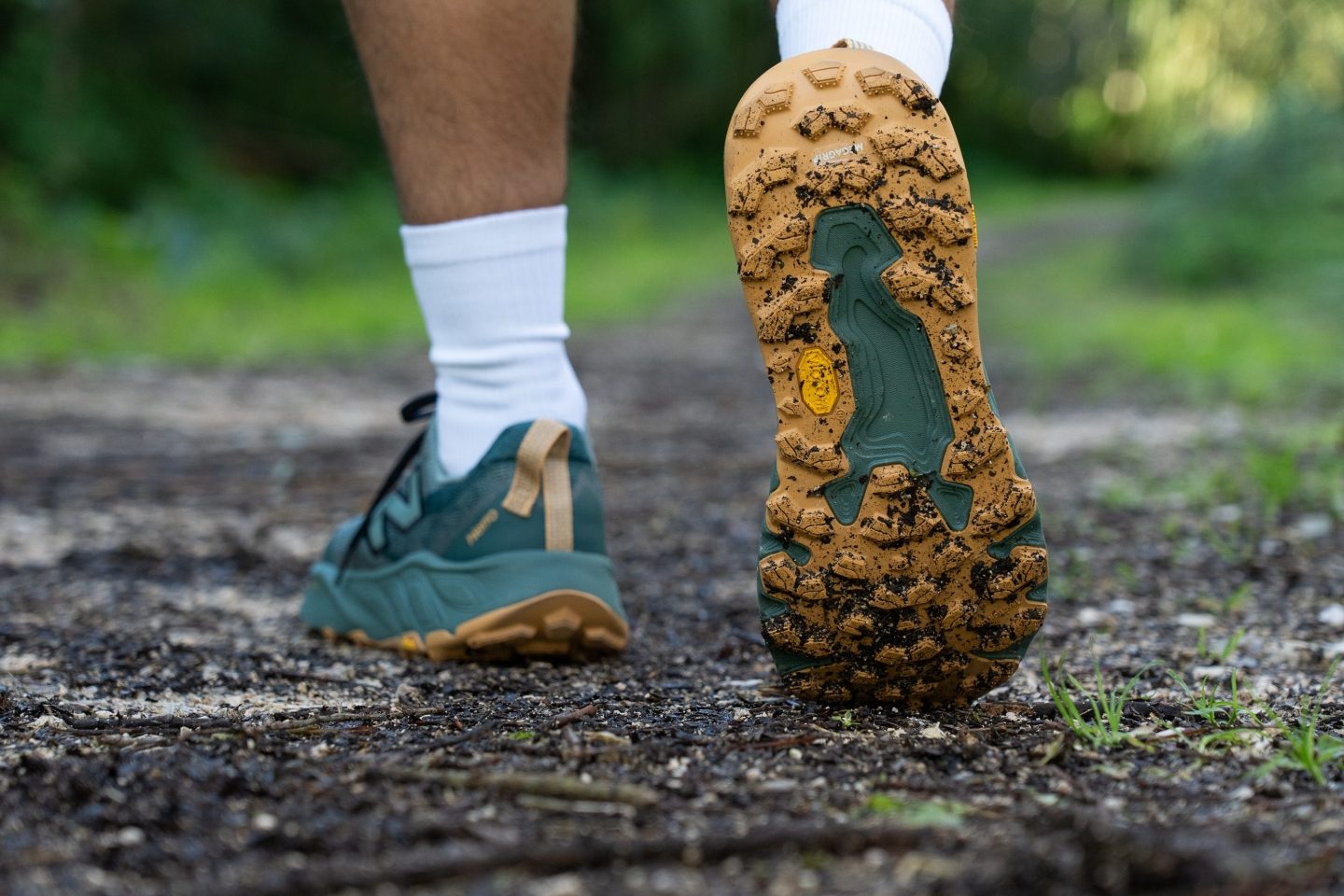
In fact, trail shoes often return more energy than it feels—because the aggressive rubber and chunky lugs absorb the impact first, dulling the sensation. That’s also why road supershoes usually skip thick outsoles entirely.
Chasing 100%: What the future holds for energy return
A 100% energy return would mean zero energy loss when the foam compresses and rebounds, something only possible with perfectly elastic materials. But in the real world, those materials don’t exist. Every real foam loses part of the input energy as heat, internal friction, or structural deformation, and this is especially true for soft foams. Even the best superfoams we’ve tested this year, such as ZoomX (PEBA) and the latest Lightstrike Pro (A-TPU), top out around 80% energy return using the ASTM F1976 protocol.
So why not add a small spring to hit over 100%? Well, World Athletics strictly prohibits any spring or mechanical device intended to boost propulsion. The rules allow only passive materials like foam and one rigid plate. So forget about embedded springs, futuristic micro-pistons, or carbon-fiber pogo sticks!
But we believe foam innovation is where brands will keep investing. PEBA once looked unbeatable… until A-TPU showed up with improved bounce and fatigue resistance. However, don’t expect another giant leap. Jumping from 50% to 80% was groundbreaking, but inching closer to 100% will be a slow, uphill climb. If we had to bet, even a 1% gain per year would already be a major win from this point forward.
And finally… Don’t buy the hype, buy the evidence

More often than not, running shoe manufacturers throw out bold claims without offering real data to back them up. Take Nike’s 2023 launch of the InfinityRN 4. They said ReactX foam “increase energy return by 13%” in the press release. But where’s the proof?
In our lab, we measured 59.8% energy return in the forefoot for the InfinityRN 4—barely higher than the 58.7% from its predecessor, the Infinity Run 3. That’s nowhere near a 13% improvement.
This is what we see most times: strong marketing, no numbers. As Marques Brownlee says, “Don’t buy hardware based on promised software updates.” We say: “Don’t buy shoes based on energy return claims without lab data.”
Luckily, we’re here to change that. We’ve tested hundreds of shoes in our lab to give you the truth about them. And it's true that sometimes brands get it right, and we applaud that. Nike nailed it with the original Vaporfly study, and PUMA followed suit with the Fast-R Elite 3. While those studies are relatively small, they’re solid enough to back up the hype—and in both cases, the shoes really deliver.
